Mississippi is home to a variety of birds, from the majestic Bald Eagle to the more subtle ruby-troated hummingbird. Bird watchers from all over the world come to Mississippi to experience the unique beauty of its avian population.
From coastal wetlands to deciduous forests, there is a wide range of habitats that support a variety of bird species.
Mississippi is home to many rare and endangered species, such as the Red-Cockaded Woodpecker and the Mississippi Kite.
Bird enthusiasts can find plenty of opportunities to observe these species in their natural habitats.
Despite their beauty, many of the birds of Mississippi are facing threats due to habitat destruction and climate change. Through conservation efforts, however, we can help ensure that these birds will be here for generations to come.
1. Northern Cardinal

The Northern Cardinal is a beautiful bird, easily identified by its bright red plumage. It can be found in the eastern United States from Maine to Minnesota and south through Mexico and Belize.
Along with its striking colouration, it has a distinctive crest on its head and sharp black facial markings around the eyes.
Despite their small size (measuring 7-9 inches) they are very vocal birds – males sing persistently throughout springtime to attract mates or proclaim their territory.
They typically feed on insects, seeds and fruits but also enjoy suet at backyard bird feeders.
The female is less brightly coloured than her mate but still stands out among other songbirds due to her warm brownish-red feathers.
Cardinals pair for life so you may often see them together in your garden or neighbourhood park.
Scientific classification:
| Kingdom | Animalia |
| Phylum | Chordata |
| Class | Aves |
| Order | Passeriformes |
| Family | Cardinalidae |
| Genus | Cardinalis |
| Species | C. cardinalis |
2. American Robin

The American robin is a migratory bird, belonging to the true thrush genus and Turdidae family.
It was named after its European counterpart due to the similar reddish-orange breast they both possess; however, they are not related closely.
This species can be seen through most of North America during winter months, as well as in parts of Mexico and Central America where it also breeds.
They have plump bodies with gray upperparts and white underparts that vary from yellow on their throats down to orange toward their bellies.
Robins feed on fruits such as berries or insects like worms which makes them an important part of ecosystems by helping disperse seeds naturally throughout these areas.
Scientific classification:
| Kingdom | Animalia |
| Phylum | Chordata |
| Class | Aves |
| Order | Passeriformes |
| Family | Turdidae |
| Genus | Turdus |
| Species | T. migratorius |
3. American Goldfinch
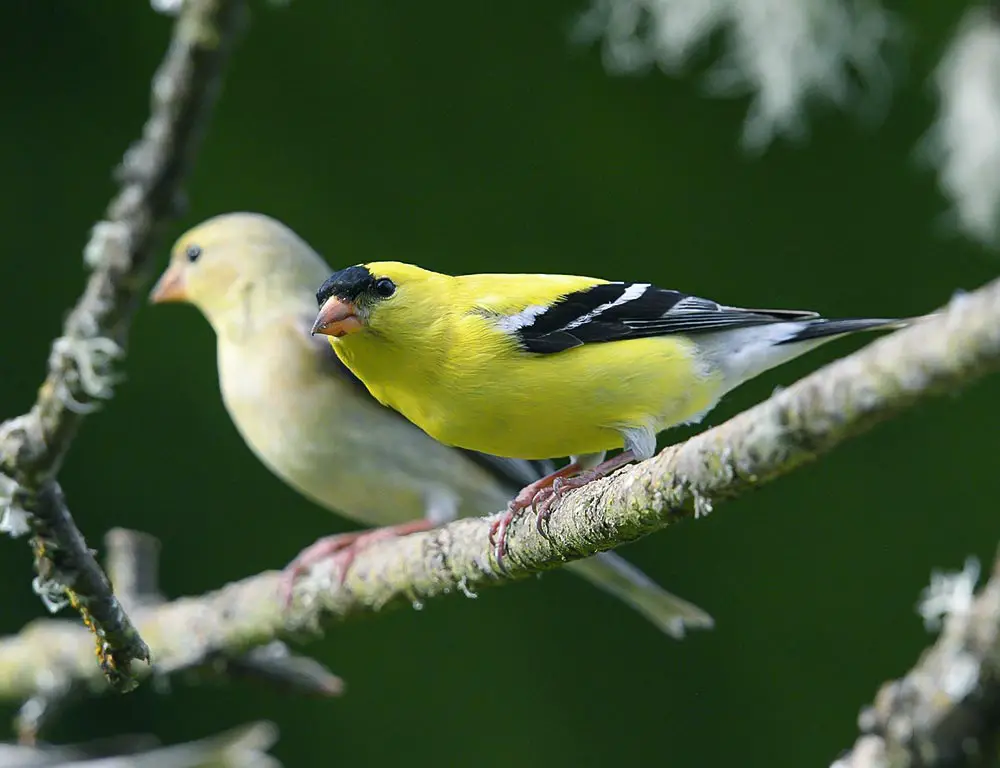
The American goldfinch is a small North American bird in the finch family. Males are vibrant yellow with black wings and tails, while females are duller in coloration.
It migrates from mid-Alberta to North Carolina during the breeding season, south of Canada–United States border to Mexico for its wintering grounds.
The only finch which undergoes complete molt every year displays sexual dichromatism where males have brighter colors than their female counterparts.
They feed mainly on seeds but also eat insects such as aphids and caterpillars when raising young; they often occur near thistles or other plants that produce viable seed heads.
Their call consists of an array of chirps and trills making them quite conspicuous.
Scientific classification:
| Kingdom | Animalia |
| Phylum | Chordata |
| Class | Aves |
| Order | Passeriformes |
| Family | Fringillidae |
| Subfamily | Carduelinae |
| Genus | Spinus |
| Species | S. tristis |
4. Northern Mockingbird
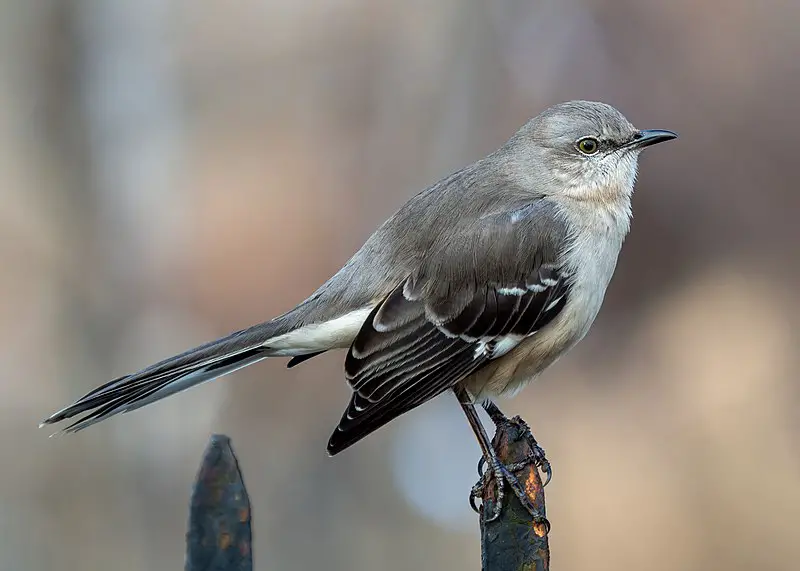
The northern mockingbird is a common fixture in North American skies. It has greyish-brown upperparts and a paler underside with white wing patches, and its distinctive long tail makes it easy to spot.
This adaptable bird can often be seen singing from the tops of trees or fences, though it rarely strays into Europe.
The species was first described by Carl Linnaeus in his 1758 Systema Naturae as Turdus polyglottos – aptly named for their remarkable ability to mimic other birds’ songs.
Northern mockingbirds typically live on insects, fruits, berries, and seeds but they will also happily scavenge food scraps left out by humans.
With its beautiful song and striking plumage, this beloved avian makes an important contribution to our environment.
Scientific classification:
| Kingdom | Animalia |
| Phylum | Chordata |
| Class | Aves |
| Order | Passeriformes |
| Family | Mimidae |
| Genus | Mimus |
| Species | M. polyglottos |
5. Blue Jay

The Blue Jay is a beautiful bird that resides in the eastern and central United States, as well as Newfoundland Canada.
They have an unmistakable blue colored plumage with white markings on their heads and wings.
These birds are highly adaptable to different habitats ranging from deciduous forests to urban areas.
As part of the Corvidae family, they are known for being intelligent problem solvers who will often use tools or mimic vocalizations of other species like hawks when defending their territories.
Their diet consists mostly of insects, seeds, and nuts but can also include small vertebrates such as frogs or lizards if food resources become scarce.
Overall these birds provide much-needed color to our environment while playing important roles in maintaining healthy ecosystems through pollination services and seed dispersal activities.
Scientific classification:
| Kingdom | Animalia |
| Phylum | Chordata |
| Class | Aves |
| Order | Passeriformes |
| Family | Corvidae |
| Genus | Cyanocitta |
| Species | C. cristata |
6. House Finch

The House Finch is a species of finch native to western North America and has been introduced in the eastern half of the continent as well as Hawaii.
It’s an average-sized finch with adults measuring 12.5 – 15 cm (5 – 6 inches) long and having wingspans between 20 – 25 cm (8 – 10 inches).
The upperparts are brown, while its underparts range from pale grayish white to yellow depending on subspecies.
Its face is streaked or spotted with reddish coloration; males typically have brighter plumage than females due to sexual dimorphism.
They’re mostly found near human habitations such as farms and gardens where they feed on grains, fruits, insects, etc., making them very popular among birders who want something colorful for their backyard.
Scientific classification:
| Kingdom | Animalia |
| Phylum | Chordata |
| Class | Aves |
| Order | Passeriformes |
| Family | Fringillidae |
| Subfamily | Carduelinae |
| Genus | Haemorhous |
| Species | H. mexicanus |
7. Brown-Headed Cowbird
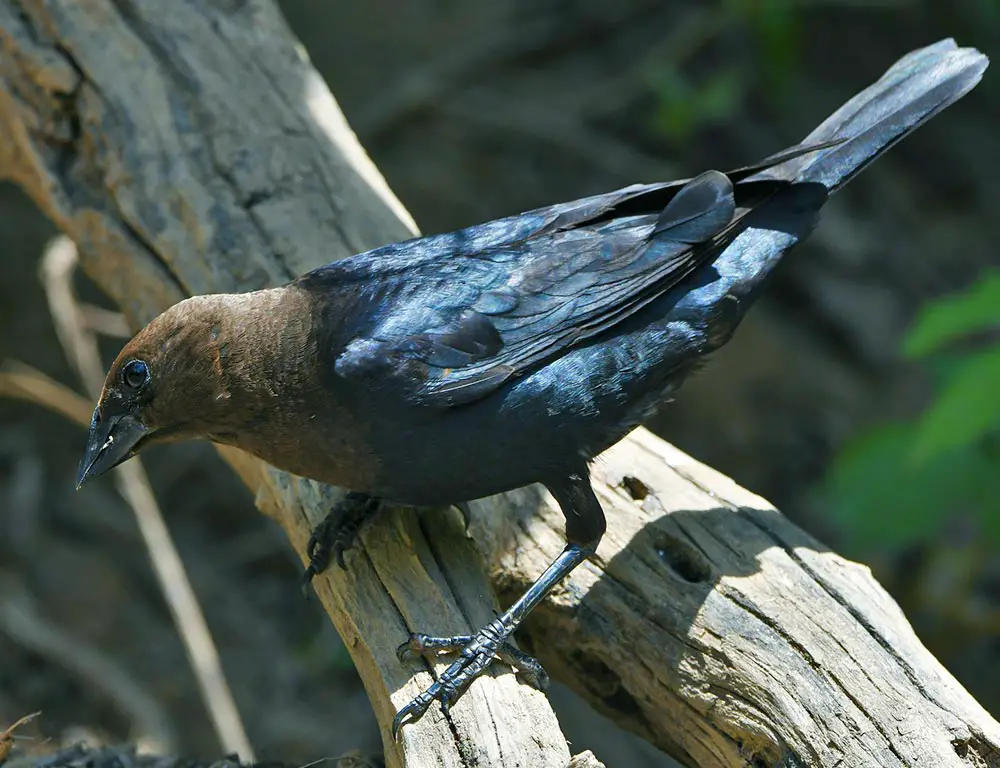
The Brown-headed Cowbird is a small, obligate brood parasitic icterid native to temperate and subtropical North America. It has a brown head with glossy black plumage on the body, wings, and tail feathers.
During summer months it can be found in prairies, grasslands as well as open wooded areas but during winter they migrate southwards towards the United States of Mexico for warmer climates.
They are mainly insectivorous birds that feed on insects like caterpillars or beetles but also consume some grains.
The female bird lays its eggs in nests of other species and then incubates them until hatching time thus leaving their chicks uncared for by themselves.
Scientific classification:
| Kingdom | Animalia |
| Phylum | Chordata |
| Class | Aves |
| Order | Passeriformes |
| Family | Icteridae |
| Genus | Molothrus |
| Species | M. ater |
8. Eastern Towhee
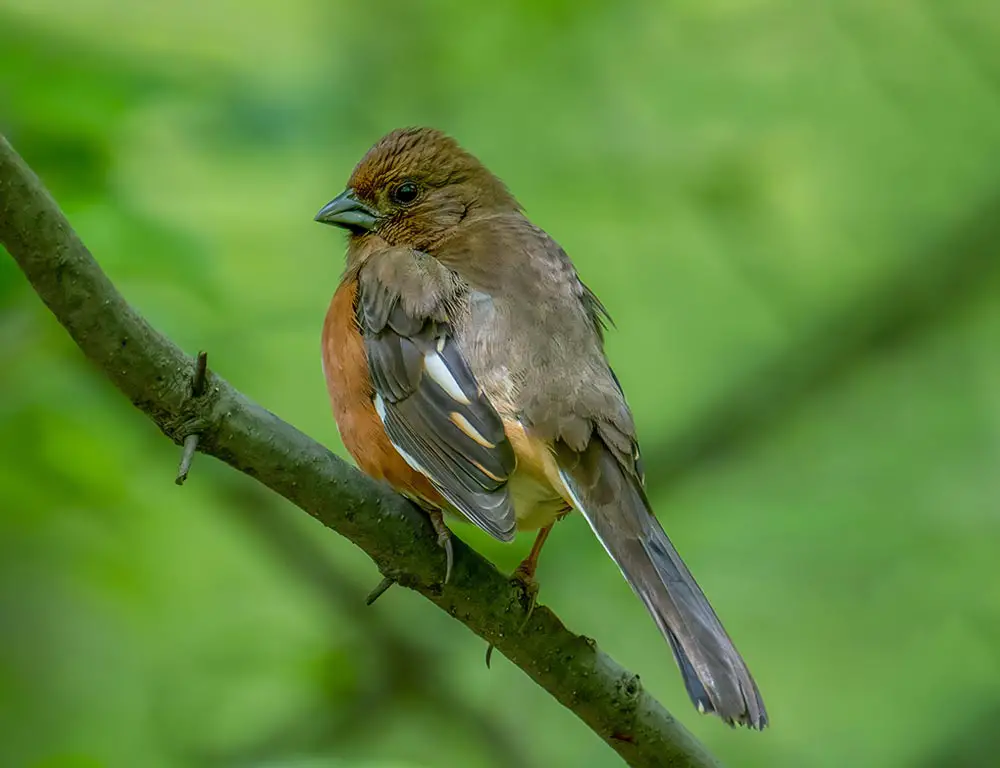
The Eastern Towhee is a large New World sparrow, native to brushy areas of eastern North America. These birds have distinct black and white markings, with chestnut brown underparts.
They nest either low in bushes or on the ground beneath shrubs. Northern towhees are known for migrating south during the winter months.
In recent decades, taxonomy debates have left some questioning whether this bird should remain its species or be grouped with the Spotted Towhee as one species — Rufous-sided Towhee.
This lively songbird has a bubbly personality and can often be seen hopping around on branches looking for food such as insects, fruits, and seeds.
Scientific classification:
| Kingdom | Animalia |
| Phylum | Chordata |
| Class | Aves |
| Order | Passeriformes |
| Family | Passerellidae |
| Genus | Pipilo |
| Species | P. erythrophthalmus |
9. Tufted Titmouse

The Tufted Titmouse is a small, cheerful songbird found in North America. It’s part of the tit and chickadee family (Paridae).
It has distinctive white feathers around its eyes, grey-brown wings, and upper body, with a pale tan underside.
Its most notable feature is the black crest on top of its head which gives it an inquisitive look. The male also sports a pinkish breast which can be seen.
When singing from high perches during the spring months. This bird loves to eat sunflower seeds or suet at backyard feeders as well as insects in summertime.
You may even see them poking into crevices and bark looking for food.
They are quite social birds too, being often spotted in mixed flocks alongside other species such as nuthatches and woodpeckers all year round.
Scientific classification:
| Kingdom | Animalia |
| Phylum | Chordata |
| Class | Aves |
| Order | Passeriformes |
| Family | Paridae |
| Genus | Baeolophus |
| Species | B. bicolor |
10. Mourning Dove
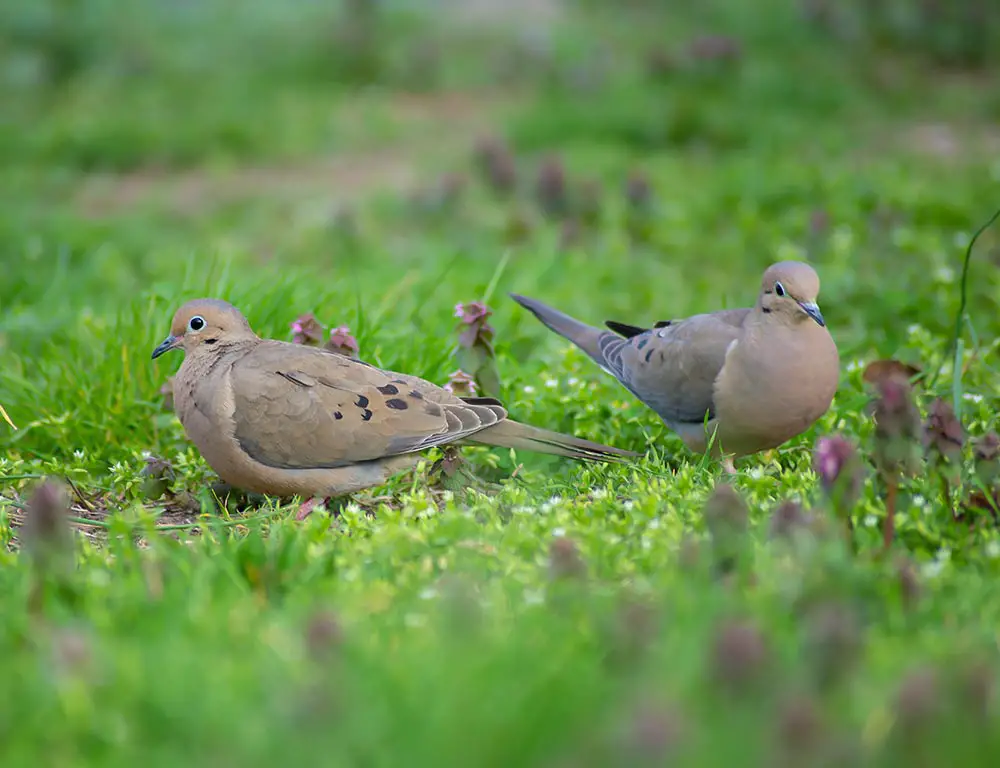
The Mourning Dove is a breathtakingly beautiful bird. It has stunning gray and brown feathers with white-tipped wings, giving it an elegant appearance. Its long tail also adds to its graceful look in flight.
A symbol of peace and serenity, they are abundant across North America and can be found in gardens or open fields throughout the year.
As well as being popular game birds for hunters, they feed on grains such as wheat and millet providing important food sources for wildlife species including foxes, coyotes, skunks, and raccoons.
These doves have a distinctive cooing sound that can often be heard echoing through woodlands during summer evenings making them one of nature’s greatest treasures.
Scientific classification:
| Kingdom | Animalia |
| Phylum | Chordata |
| Class | Aves |
| Order | Columbiformes |
| Family | Columbidae |
| Genus | Zenaida |
| Species | Z. macroura |
11. Downy Woodpecker
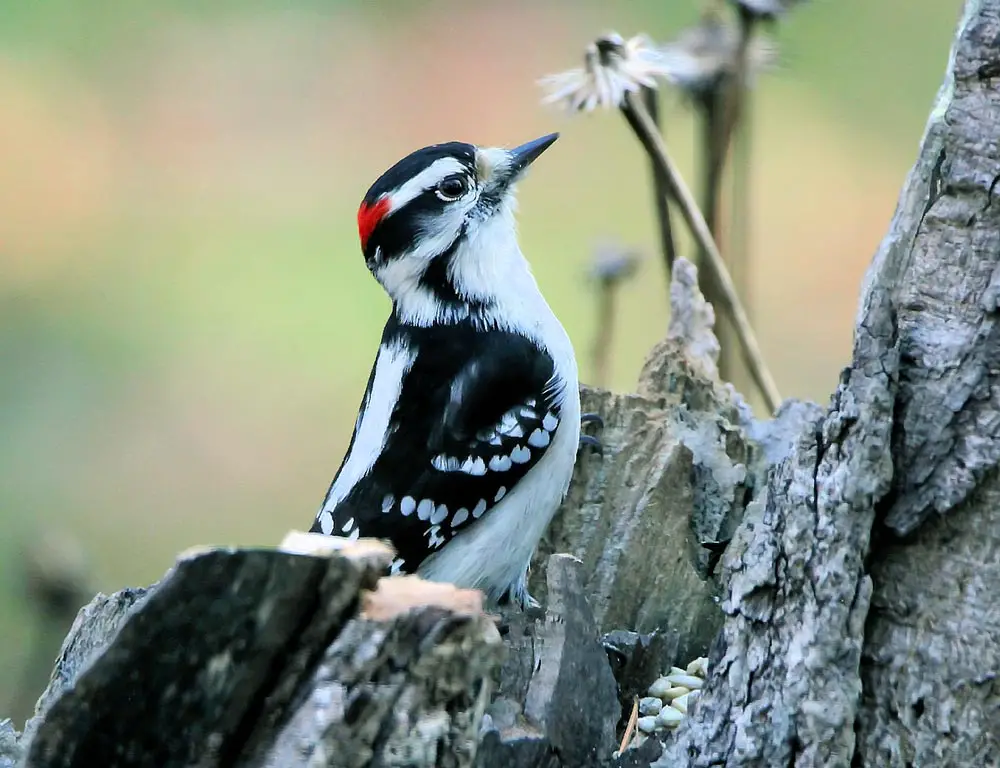
The downy woodpecker is a small species of woodpecker found in North America. Growing up to 7 inches long, it can be identified by its white belly and spotted wings.
It inhabits forests throughout the United States and Canada, except deserts in the southwest and northern tundra.
This bird nests in tree cavities and feeds mostly on insects but will supplement its diet with fruit or nuts when available.
The Downy Woodpecker has an unmistakable call that sounds like a loud ‘piker’, similar to other members of its family such as the Hairy Woodpecker.
Scientific classification:
| Kingdom | Animalia |
| Phylum | Chordata |
| Class | Aves |
| Order | Piciformes |
| Family | Picidae |
| Genus | Dryobates |
| Species | D. pubescens |
12. Yellow-Rumped Warbler

The Yellow-rumped Warbler (Setophaga coronata) is a migratory bird species that can be found throughout North America.
It has an extensive range, from the Pacific and Atlantic coasts of the US to Canada and Central America, with a concentration in northern areas during the breeding season.
These birds migrate southwards for wintering grounds where they find plentiful food sources such as insects and berries.
They are easily identified by their yellow patches on either side of their tails, along with white underparts, gray back feathers, and two distinct crown stripes.
One black or greyish-brown above the eyes extending towards its neck banded in yellow or light brown coloration.
Furthermore, these warblers have strong legs which allow them to cling onto branches while hunting for prey making them adept at maneuvering through tree cover quickly.
Altogether this makes the Yellow-rumped Warbler an attractive backyard visitor year-round.
Scientific classification:
| Kingdom | Animalia |
| Phylum | Chordata |
| Class | Aves |
| Order | Passeriformes |
| Family | Parulidae |
| Genus | Setophaga |
| Species | S. coronata |
13. Red-Winged Blackbird

The red-winged blackbird is a beautiful bird found in most of North America and Central America.
Its distinct features include a glossy black body, with white shoulder patches and bright red wing coverts year round.
It prefers wetland habitats such as marshes, ponds, lakeshores, and agricultural fields. During breeding season they inhabit grassy areas near water then move south for the winter months.
For food, they mainly eat insects but also consume wild fruit or grains.
They are very social birds often seen in large flocks during migration times when their unmistakable “conk-la-ree” call can be heard echoing across the sky.
Scientific classification:
| Kingdom | Animalia |
| Phylum | Chordata |
| Class | Aves |
| Order | Passeriformes |
| Family | Icteridae |
| Genus | Agelaius |
| Species | A. phoeniceus |
14. Eastern Bluebird
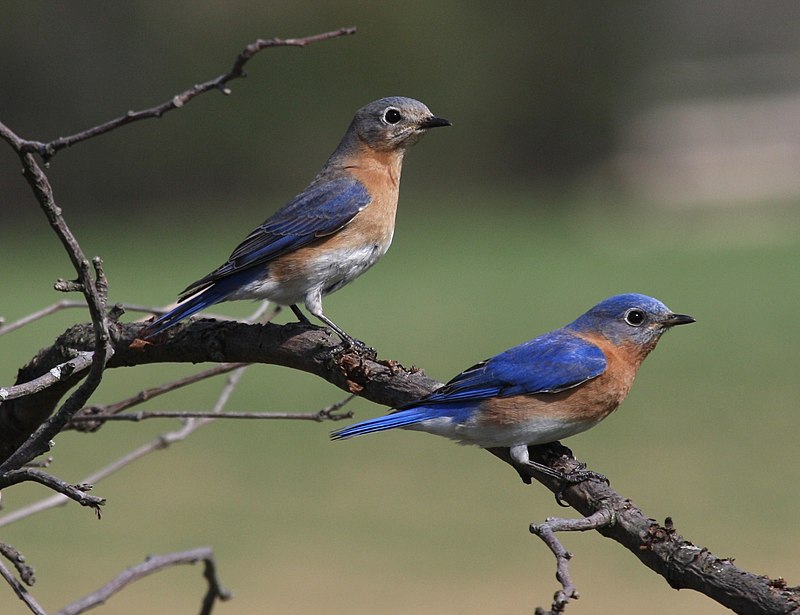
The Eastern bluebird is a small migratory thrush that can be found in open woodlands, farms, and orchards across North America.
The male has bright-blue breeding plumage which makes it easily recognizable by birders.
It produces melodious songs such as jeew, chir-wi, and chiti WEEW wewidoo.
This popular species was declared the state bird of Missouri back in 1927 due to its beauty and charm.
In addition to being beautiful, these birds are also beneficial for farmers because they eat insects like grasshoppers and beetles which damage crops.
They nest in cavities so providing nesting boxes helps them thrive even more.
With their vibrant colors, sweet melodies, and helpful nature it’s easy to see why the Eastern Bluebird is beloved worldwide.
Scientific classification:
| Kingdom | Animalia |
| Phylum | Chordata |
| Class | Aves |
| Order | Passeriformes |
| Family | Turdidae |
| Genus | Sialia |
| Species | S. sialis |
15. Carolina Chickadee
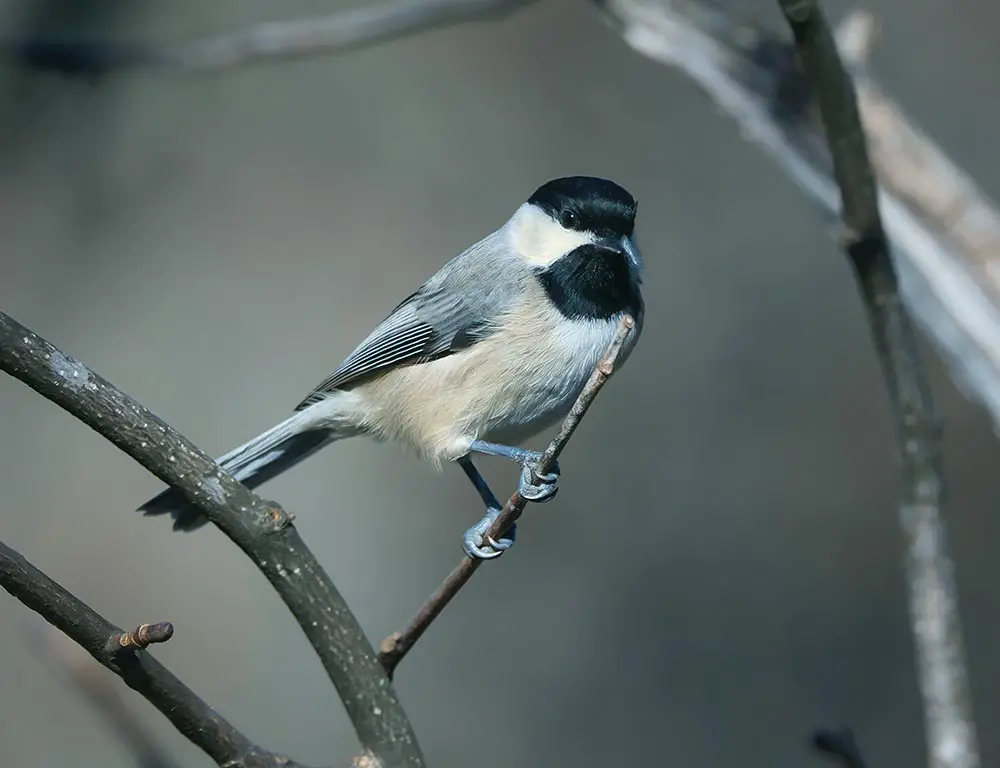
The Carolina Chickadee is a small passerine bird found in the tit family Paridae. It stands out for its distinct black and white, grey-brown feathers with an off-white underside.
This species can be spotted by its call: “chick-a-dee”. The American Ornithologists’ Union has classified them into their genus called Poecile as they differ from other tits due to both genetic data and morphology.
These birds are found all over North America, living in wooded areas near open fields or water sources.
They feed on insects such as caterpillars but also have been known to eat suet at backyard feeders during winter months when food is scarce.
Scientific classification:
| Kingdom | Animalia |
| Phylum | Chordata |
| Class | Aves |
| Order | Passeriformes |
| Family | Paridae |
| Genus | Poecile |
| Species | P. carolinensis |
16. Red-bellied woodpecker
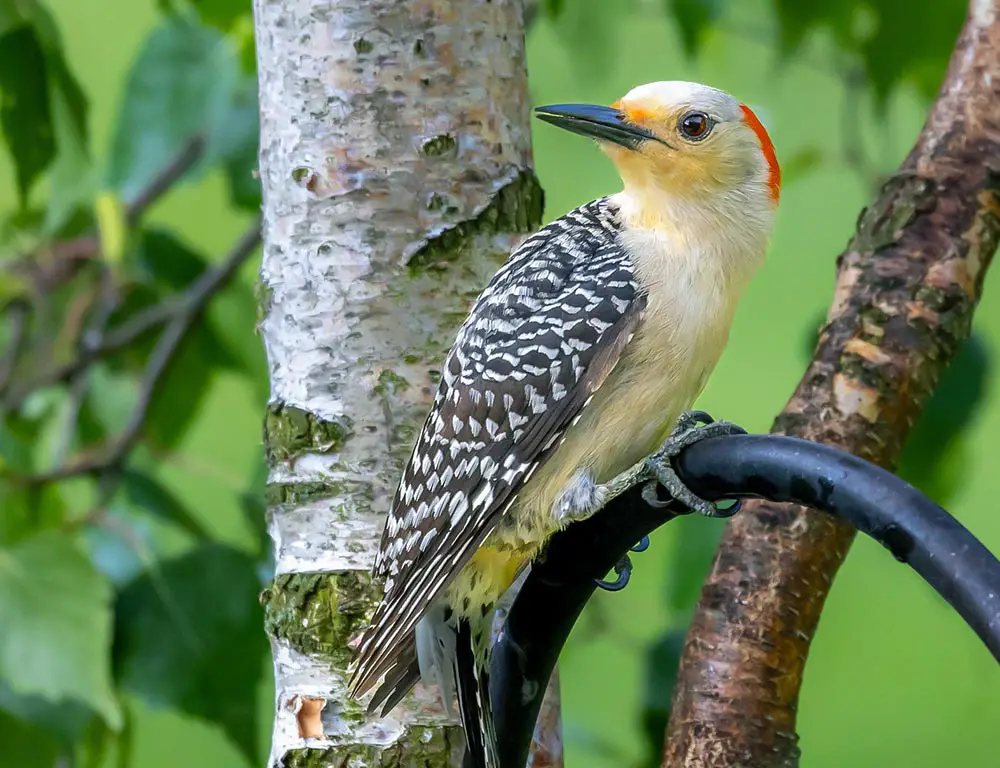
The Red-bellied woodpecker is a beautiful bird with an orange-red crown and nape. It breeds mainly in the eastern United States, ranging from Florida to Canada.
This medium-sized woodpecker of the family Picidae has black wings, white stripes on its back, and tail feathers that are barred with black.
Its underside is mostly pale yellow or white but it also features some red coloration around its neck area.
Despite this subtle red hue, it should not be mistaken for the entirely red head and neck belonging to the Red-headed woodpecker of the same genus Melanerpes carolinus.
The Red-bellied Woodpeckers diet consists primarily of insects such as ants, beetles, and grasshoppers along with nuts fruits berries, and tree sap which they will feed upon at different times throughout their life cycle.
Scientific classification:
| Kingdom | Animalia |
| Phylum | Chordata |
| Class | Aves |
| Order | Piciformes |
| Family | Picidae |
| Genus | Melanerpes |
| Species | M. carolinus |
17. Carolina Wren
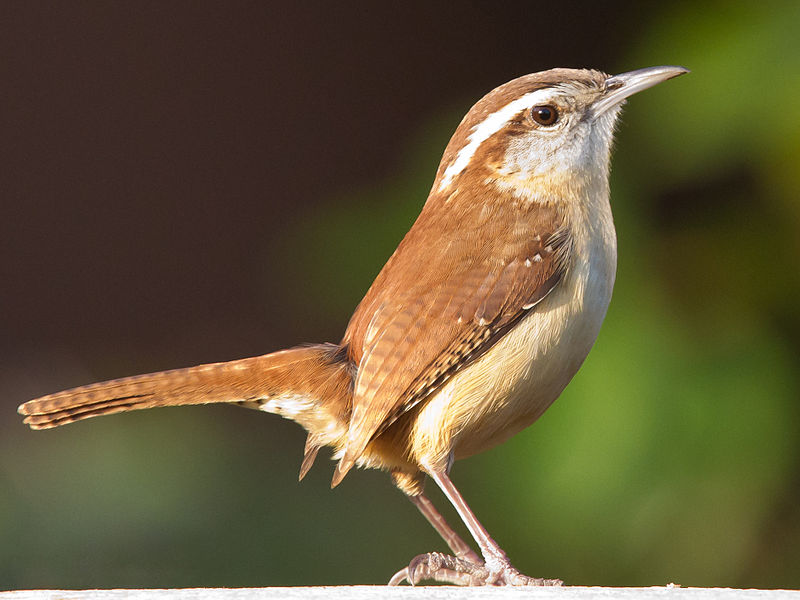
The Carolina wren (Thryothorus ludovicianus) is a medium-sized bird that can be found in the eastern United States, southern Ontario, and northeast Mexico.
They typically live in dense shrubbery or thickets near open areas such as gardens, parks, and woodland edges.
These birds are quite adaptable when it comes to nesting sites – they will build their nests anywhere from tree cavities to manmade boxes.
Their diet consists of insects, spiders, and other invertebrates which they forage for on the ground or among vegetation.
The males have an unmistakable song made up of loud whistles interspersed with trills reminiscent of laughter; you’ll often find these cheerful little birds singing away during early morning hours.
Scientific classification:
| Kingdom | Animalia |
| Phylum | Chordata |
| Class | Aves |
| Order | Passeriformes |
| Family | Troglodytidae |
| Genus | Thryothorus Vieillot, 1816[2] |
| Species | T. ludovicianus |
18. White-Throated Sparrow

The White-throated Sparrow is a small passerine bird of the New World sparrow family Passerellidae.
It has distinctive yellow and black stripes on its head, white throat, and chest with grey back and wings, along with light brown legs.
The scientific name “Zonotrichia albicollis” comes from Ancient Greek for ‘band’ (ζώνη) referring to its distinctive striped crown, and Latin for ‘white neck’ (albus collum).
These birds are usually found in wooded areas such as coniferous forests or deciduous habitats in North America where they feed mainly on insects during summer months; transitioning to seeds during winter.
They build their nests near ground level using grasses, twigs, or moss lined with feathers.
White-throated Sparrows may be solitary but also form flocks when migrating southward each fall season which typically occurs over mid-late October through November depending on location within range.
Scientific classification:
| Kingdom | Animalia |
| Phylum | Chordata |
| Class | Aves |
| Order | Passeriformes |
| Family | Passerellidae |
| Genus | Zonotrichia |
| Species | Z. albicollis |
19. Common Yellowthroat

The Common Yellowthroat is a small, New World Warbler found throughout North America. It has distinctive yellow and black plumage that earned it the nickname “Yellow Bandit” in the Midwest United States.
This species is highly adaptable and can be found inhabiting wetlands, grasslands, shrubland habitats, as well as suburban areas.
The genus of this bird’s scientific name translates to mean ‘ground’ and ‘small bird’, which are fitting characteristics for such an elusive yet common little creature.
Its diet consists predominantly of insects but may also include other invertebrates like spiders or worms.
Overall the Common Yellowthroat makes an excellent addition to any backyard with its cheerful song.
Scientific classification:
| Kingdom | Animalia |
| Phylum | Chordata |
| Class | Aves |
| Order | Passeriformes |
| Family | Parulidae |
| Genus | Geothlypis |
| Species | G. trichas |
20. Ruby-Throated Hummingbird

The ruby-throated hummingbird (Archilochus colubris) is a species of hummingbird that has an impressive migration pattern, spending the winter in Central America, Mexico, and Florida before flying to Canada and other parts of Eastern North America for the breeding season.
It’s by far the most common type seen east of the Mississippi River in North America.
Formally described by Swedish naturalist Carl Linnaeus in 1758, this tiny bird has bright metallic green upperparts with white underparts, a small black bill, and a red throat patch which gives it its name; they measure around 3 inches long on average.
They feed primarily on nectar from flowers but also eat insects such as flies or mosquitoes for extra protein during their migrations or when raising young chicks.
Scientific classification:
| Kingdom | Animalia |
| Phylum | Chordata |
| Class | Aves |
| Order | Apodiformes |
| Family | Trochilidae |
| Genus | Archilochus |
| Species | A. colubris |
21. Purple Finch

The Purple Finch is a species of finch from North America, belonging to the Fringillidae family.
It’s also known as an “American Rosefinch” due to its resemblance in color and size to some European rosefinches.
Their plumage ranges from pinkish-purple on their heads and wings, with a light brown underside.
They are small birds that measure about 5-6 inches long with short thin beaks for eating seeds and insects.
In addition, they have thick round bodies which help them stay warm during cold winters in the northern parts of their range.
The Purple Finch has adapted well over time making it easier for them to survive even though there are increasing threats posed by humans such as deforestation or habitat destruction caused by development projects near their habitats.
Scientific classification:
| Kingdom | Animalia |
| Phylum | Chordata |
| Class | Aves |
| Order | Passeriformes |
| Family | Fringillidae |
| Subfamily | Carduelinae |
| Genus | Haemorhous |
| Species | H. purpureus |
22. Indigo Bunting
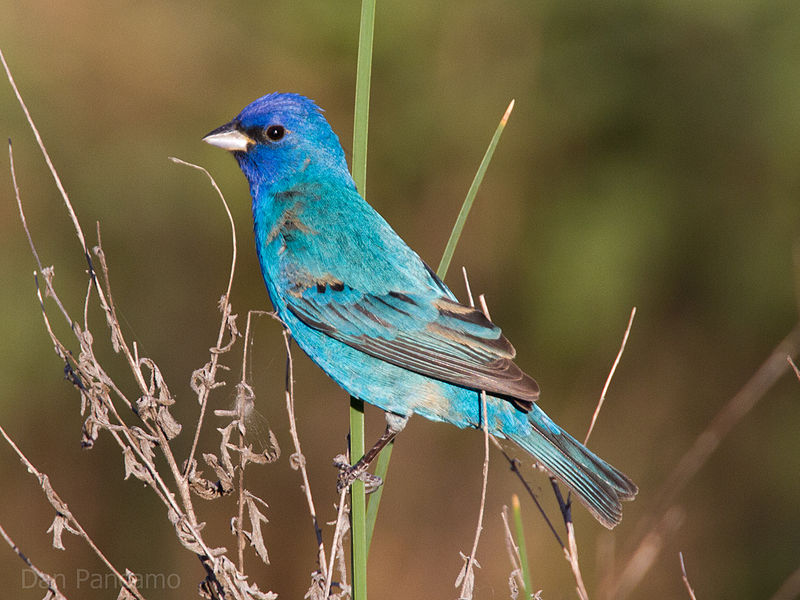
The Indigo Bunting is a small bird in the cardinal family, found throughout North and South America.
It has an unmistakable bright blue plumage that stands out against its natural habitat of farmland, brush areas, and open woodland.
During breeding season it can be seen from southern Canada to northern Florida while during winter months it migrates south towards Central and Northern South America.
The Indigo Bunting prefers to migrate at night using the stars as navigation aids.
This species feeds on insects and seeds which they find near the ground or catch mid-flight with their agile wingspan.
An iconic sight for many farmers across both continents, these birds are a welcome addition to any backyard oasis or wildflower meadow.
Scientific classification:
| Kingdom | Animalia |
| Phylum | Chordata |
| Class | Aves |
| Order | Passeriformes |
| Family | Cardinalidae |
| Genus | Passerina |
| Species | P. cyanea |
23. Mississippi Kite
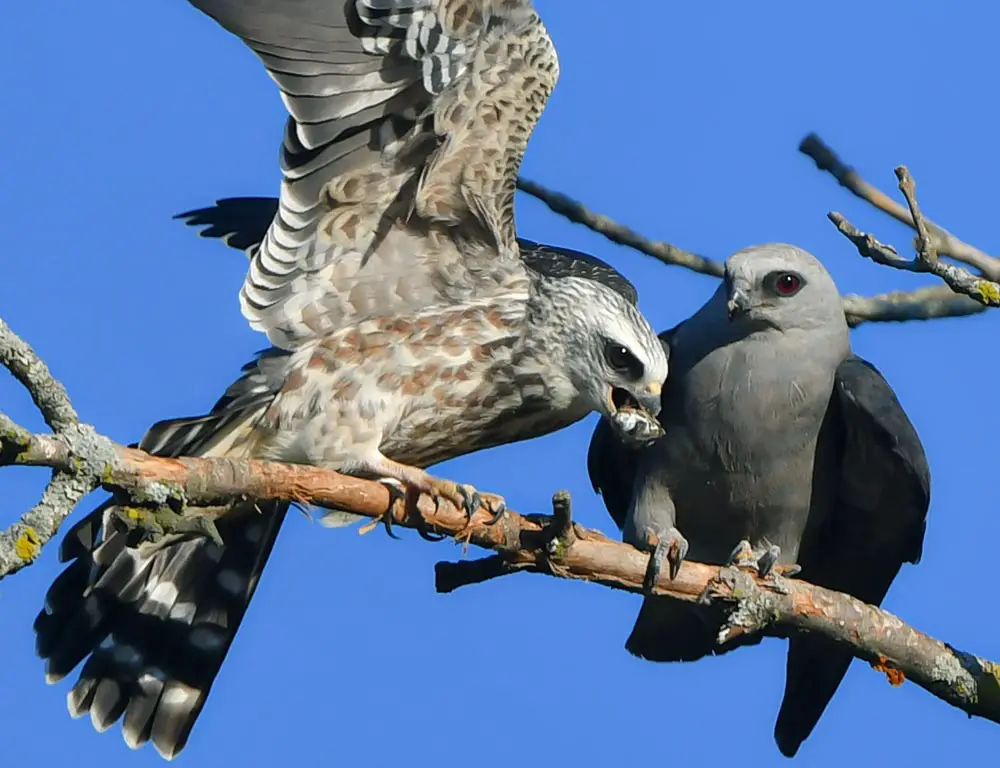
The Mississippi kite is a small raptor belonging to the family Accipitridae. It has long, narrow wings that give it an elegant flight style, often appearing to float in the air.
This bird of prey can be found circling its habitat and is also known for being highly social with other birds of its kind – sometimes several can be seen together at once.
First named by Scottish ornithologist Alexander Wilson in 1811, this species typically inhabits open grasslands or savanna areas across parts of North America.
The Mississippi kite feeds mainly on insects but will occasionally hunt small rodents as well.
These beautiful creatures have reddish-brown plumage on their backs and pale grey heads and breasts which make them quite distinguishable from most other avian species.
Scientific classification:
| Kingdom | Animalia |
| Phylum | Chordata |
| Class | Aves |
| Order | Accipitriformes |
| Family | Accipitridae |
| Genus | Ictinia |
| Species | I. mississippiensis |
Also Featured In: Birds that Live in Mississippi,
24. Hooded Warbler
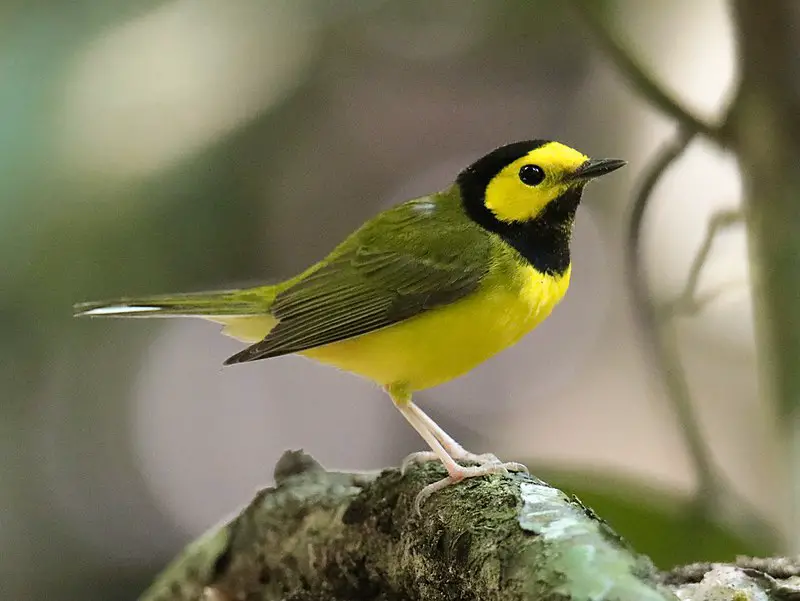
The Hooded Warbler is a species of New World warblers that breed in eastern North America and migrate to Central America and the West Indies for winter.
It has distinctive yellow, hood-like markings on its head which distinguish it from other similar-looking birds.
Recent genetic research suggests that this bird was originally classified as Wilsonia citrina, making it one of the oldest known species discovered by scientists today.
The Hooded Warbler can be found near moist woodlands where they feed mainly on insects such as caterpillars and grasshoppers.
They have also been observed eating fruits including wild cherries during migration periods when food sources are scarce.
This unique little bird plays an important role in maintaining healthy ecosystems throughout their range; however, climate change may pose serious threats to their survival if not addressed soon enough.
Scientific classification:
| Kingdom | Animalia |
| Phylum | Chordata |
| Class | Aves |
| Order | Passeriformes |
| Family | Parulidae |
| Genus | Setophaga |
| Species | S. citrina |
25. Red-Tailed Hawk
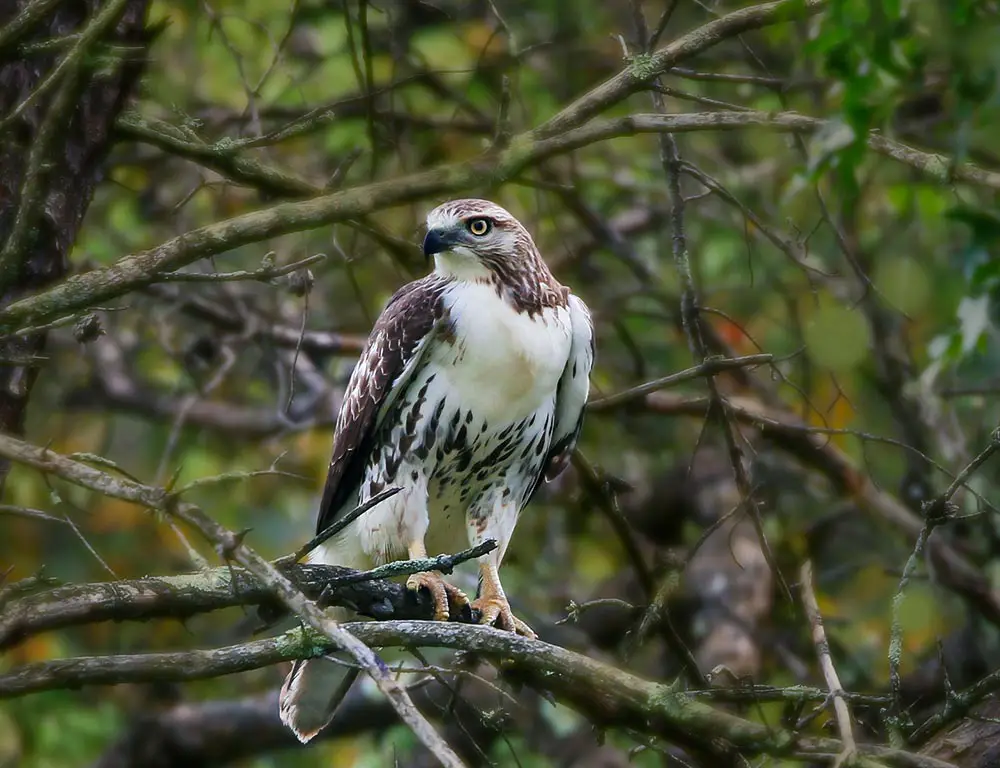
The Red-tailed Hawk is a majestic bird of prey with a distinctive red tail. It can be found throughout North America, from Alaska in the north to Panama and the West Indies in the south.
This species belongs to the Buteo genus, which makes it one of the most common raptors on Earth.
These hawks mainly hunt small mammals such as rabbits or squirrels but also feed on reptiles and birds during migration season.
Unlike other predator birds, they prefer open areas for hunting like fields or grasslands rather than dense forests.
They build their nests high up on trees where they stay all year long unless disturbed by humans or animals nearby.
Their presence has become an iconic part of American culture due to their frequent sightings around homes and parks alike making them beloved creatures among people everywhere.
Scientific classification:
| Kingdom | Animalia |
| Phylum | Chordata |
| Class | Aves |
| Order | Accipitriformes |
| Family | Accipitridae |
| Genus | Buteo |
| Species | B. jamaicensis |
26. Summer Tanager
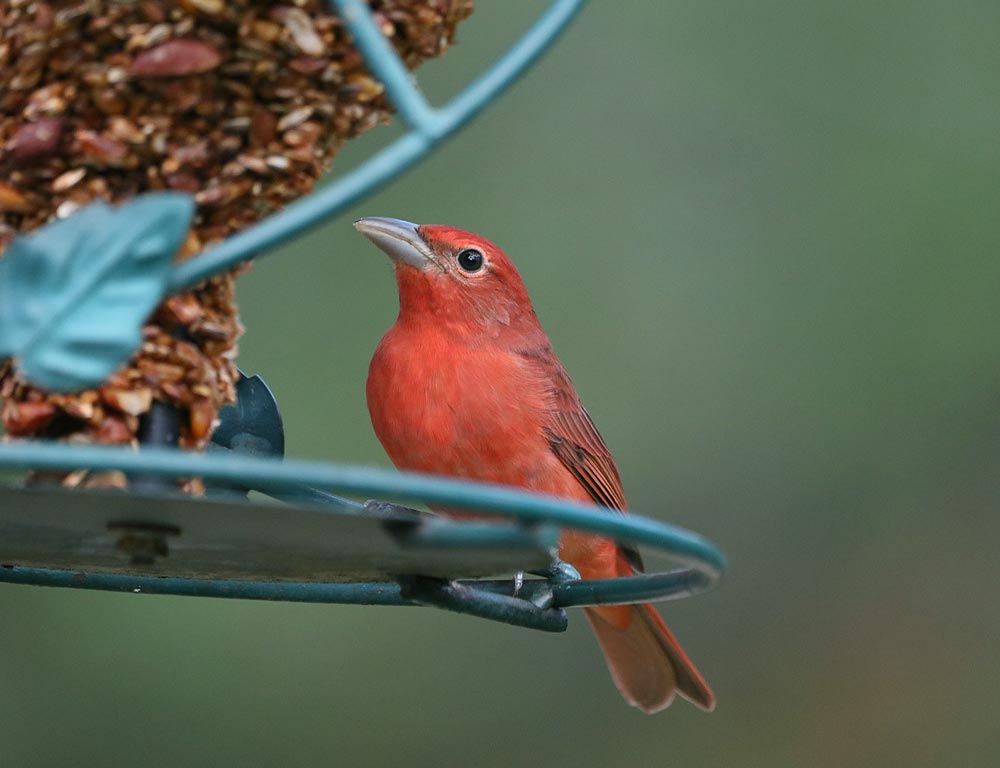
The Summer Tanager is a stunningly beautiful member of the cardinal family. Native to North and South America, this medium-sized songbird features striking red plumage on its back with yellow underparts.
It has a pointed black bill and long tail feathers that can be seen fluttering through the air when it flies.
The species’ vocalizations are quite similar to those of other members of its genus as well, which often include short whistles and chirps in addition to longer songs made up of various phrases or syllables.
With their vibrant colors and melodic voices, these birds make an eye-catching sight any time they appear.
Scientific classification:
| Kingdom | Animalia |
| Phylum | Chordata |
| Class | Aves |
| Order | Passeriformes |
| Family | Cardinalidae |
| Genus | Piranga |
| Species | P. rubra |
27. White-Eyed Vireo
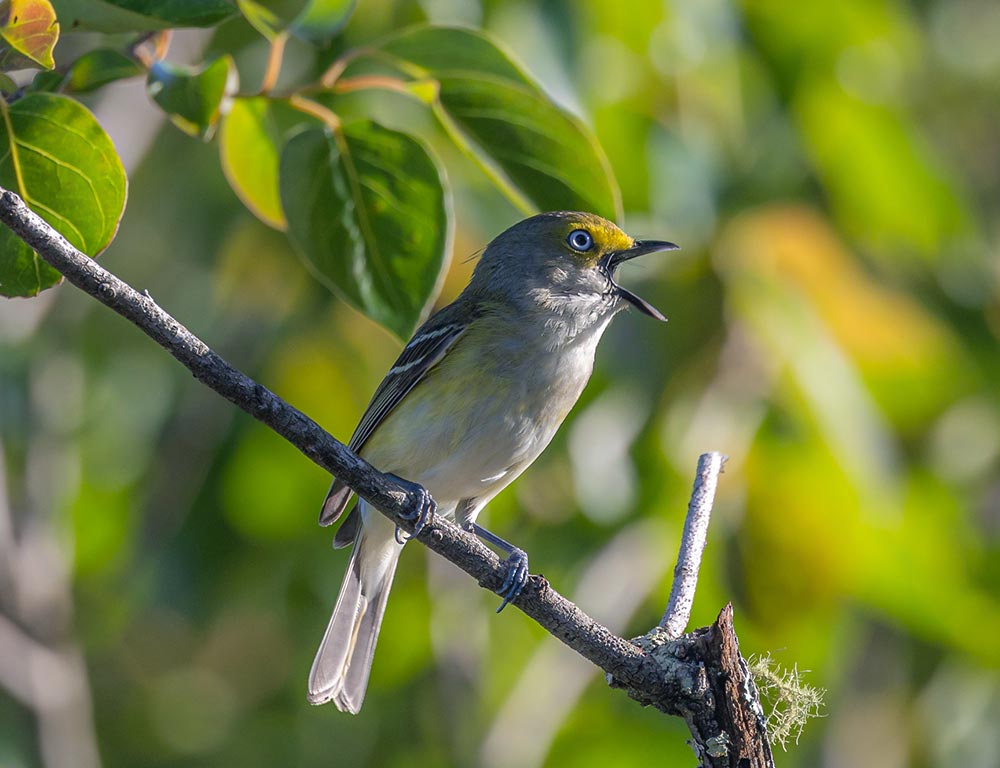
The White-eyed vireo is a small songbird in the family Vireonidae, native to parts of the eastern United States from New England to northern Missouri, Texas, and Florida.
It also occurs in Mexico, Central America, Cuba, and Caribbean islands such as the Bahamas.
These birds are migratory on their North American range but become resident further south towards the Gulf Coast.
They inhabit wooded areas with thick shrubbery or foliage which offer plenty of insects for them to feed upon.
Their call consists of sharp ‘chick’ notes while they sing a sweet melodious warble during breeding season making them popular among birdwatchers all over the world.
Scientific classification:
| Kingdom | Animalia |
| Phylum | Chordata |
| Class | Aves |
| Order | Passeriformes |
| Family | Vireonidae |
| Genus | Vireo |
| Species | V. griseus |
28. House Wren
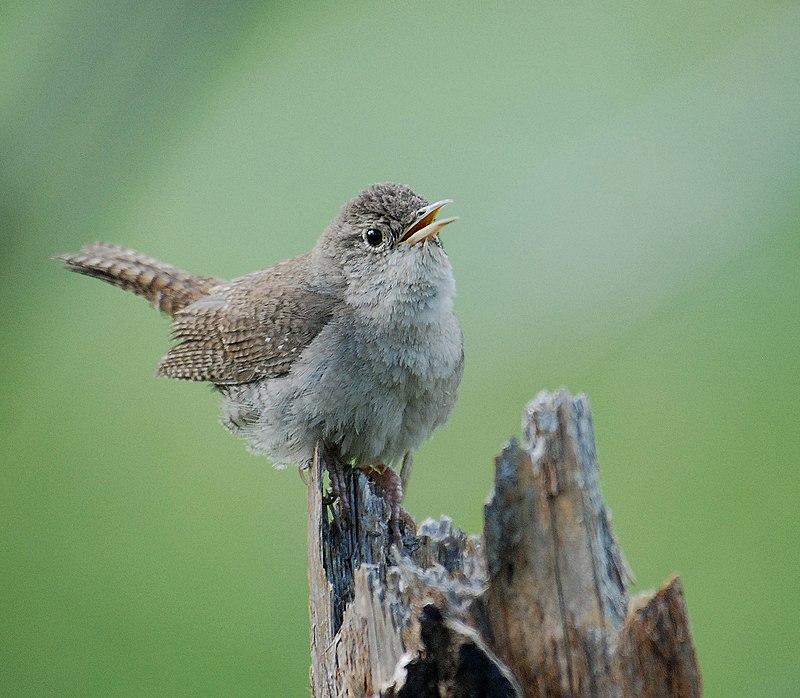
The House Wren is a small bird of the Wren family found from Canada to South America. It’s quite common in suburban areas and is one of the most widely distributed native birds in North and South America.
Its taxonomy can be complicated, with some subspecies groups considered separate species.
The House Wren has a brown back, grey head, white eyebrow stripes, light chestnut belly, and buffy flanks.
They often inhabit old or abandoned buildings as well as shrublands near fields or open woods for nesting sites.
During breeding season they are highly territorial so make sure you create an inviting environment if you wish to invite them into your yard.
Scientific classification:
| Kingdom | Animalia |
| Phylum | Chordata |
| Class | Aves |
| Order | Passeriformes |
| Family | Troglodytidae |
| Genus | Troglodytes |
| Species | T. aedon |
29. Wood Thrush
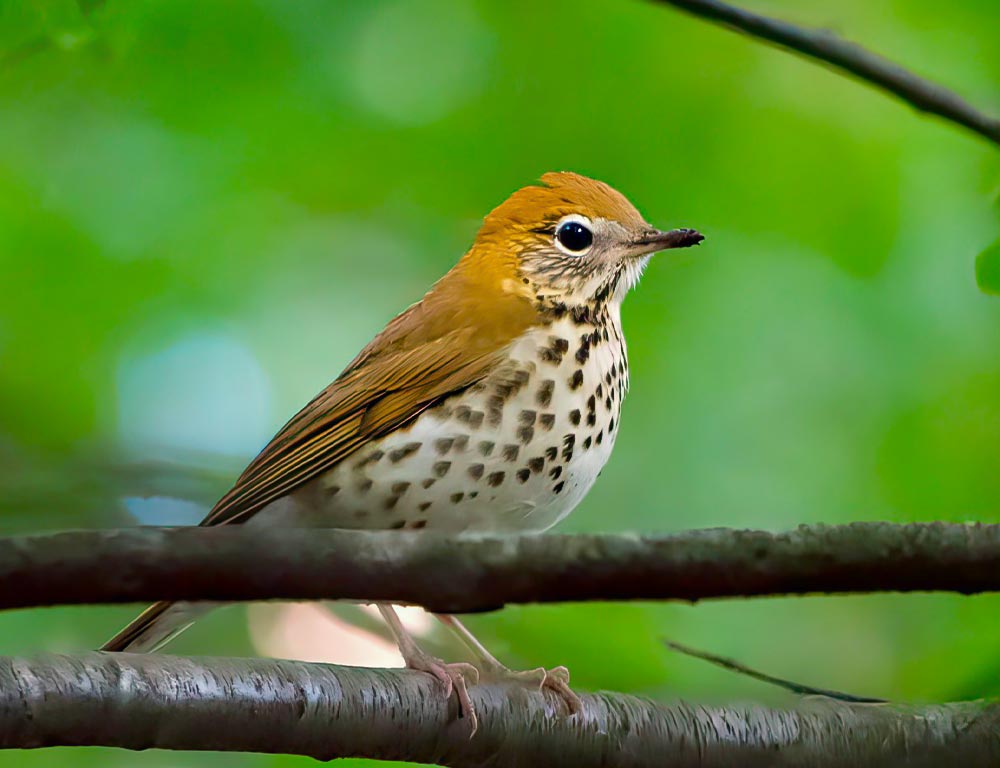
The Wood Thrush is a beautiful bird native to North America, closely related to the American Robin.
It has mottled brown and white upperparts with a spotted breast, buffy sides and flanks, and reddish-brown tail feathers.
This medium-sized thrush prefers wooded areas where it can find its favorite food – insects such as beetles, caterpillars, and spiders.
The male’s song is one of the most recognizable sounds in nature; an ethereal mix of flute-like whistles that often echoes through forests on warm summer nights.
The Wood Thrush holds special status as the official bird of Washington D.C., making it even more beloved amongst residents who take pride in seeing this exquisite species up close.
Scientific classification:
| Kingdom | Animalia |
| Phylum | Chordata |
| Class | Aves |
| Order | Passeriformes |
| Family | Turdidae |
| Genus | Hylocichla Baird, 1864 |
| Species | H. mustelina |
30. Eastern Phoebe
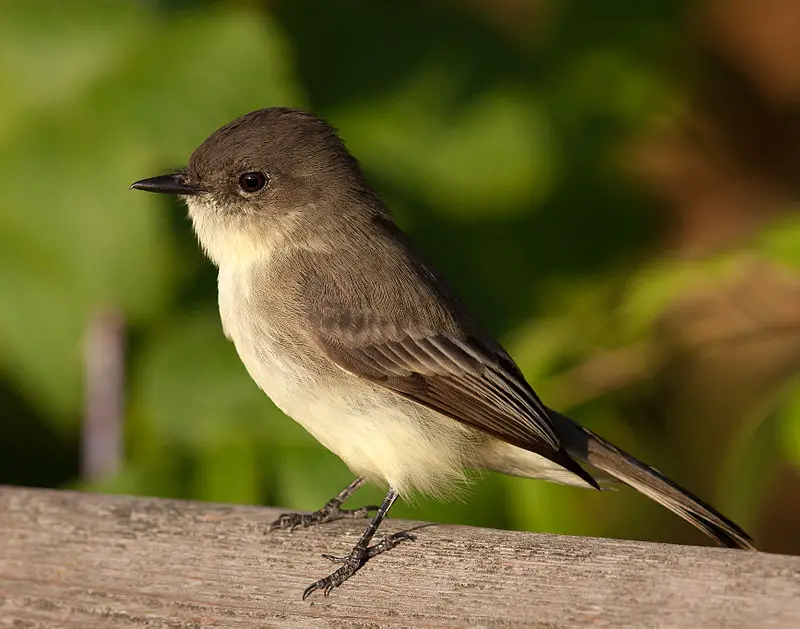
The Eastern Phoebe is a small passerine bird belonging to the genus Sayornis. It gets its name from Charles Lucien Bonaparte’s Muscicapa saya, and Ancient Greek ornis meaning “bird”.
The species’ alternative name ‘Phoebe’ comes from the Roman moon goddess Diana, but also has been said to imitate their call.
Measuring up to 16 cm in length with a wingspan of 25–30 cm, they have grayish brown upperparts and pale underparts.
They are found near streams, woodlands, and open fields where they hunt for insects such as flies, bees wasps, etc., often catching them midair or by sallying out from perches like branches or fences.
These birds make shallow cup nests made of grasses lined with mud which are built on cliffs ledges walls buildings bridges trees etc.
All in all this beautiful little bird is an interesting addition wherever you find it.
Scientific classification:
| Kingdom | Animalia |
| Phylum | Chordata |
| Class | Aves |
| Order | Passeriformes |
| Family | Tyrannidae |
| Genus | Sayornis |
| Species | S. phoebe |
31. Orchard Oriole
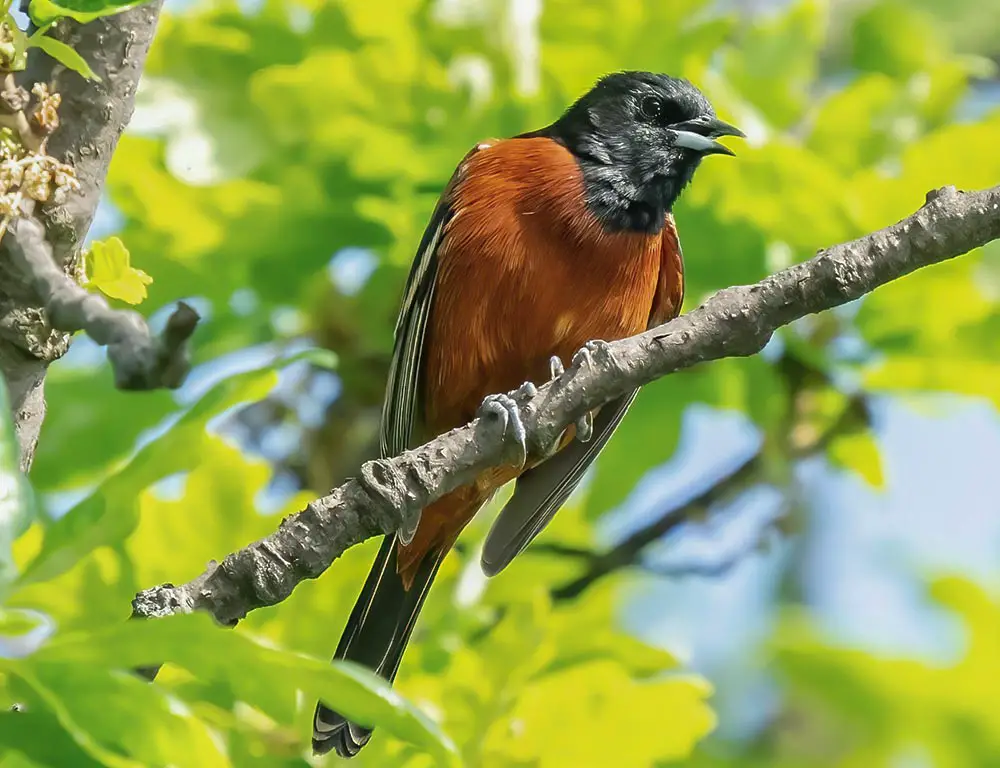
The Orchard Oriole is a small species of icterid bird, with the subspecies I. s. fuertesi is sometimes considered its separate species are known as the Ochre or Fuertes’ Oriole.
The adult male of the nominate subspecies has chestnut upperparts and black wings and tail, while females are more yellowish-green in coloration on their back and wings.
Its bill is pointed, black with some blue-gray at the base of its lower mandible.
This beautiful bird can also be found across North America during migration season; they inhabit woodlands near streams or rivers to breed before migrating south for winter months.
Scientific classification:
| Kingdom | Animalia |
| Phylum | Chordata |
| Class | Aves |
| Order | Passeriformes |
| Family | Icteridae |
| Genus | Icterus |
| Species | I. spurius |
32. American Redstart
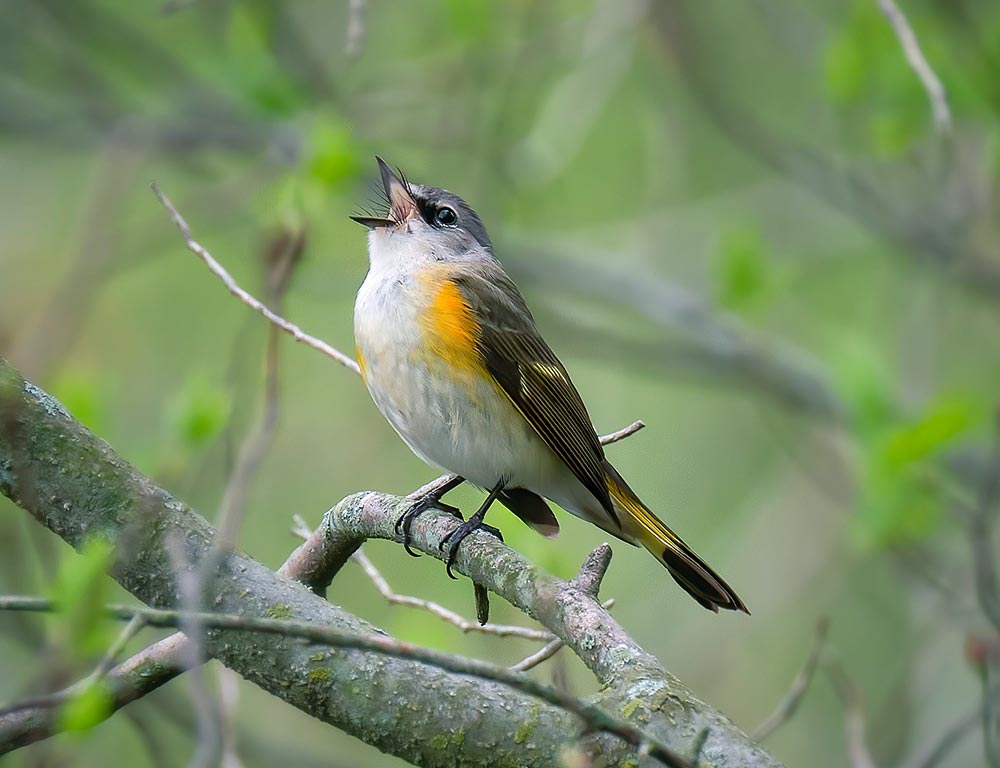
The American Redstart is a beautiful New World Warbler, first documented by Carl Linnaeus in 1758.
It has an elegant black and orange plumage that sets it apart from other birds.
The genus name Setophaga comes from the Ancient Greek words ‘sēs’ meaning moth and ‘phagos’, which means eating – referencing its insect-eating habits.
Its song is one of joy, with short repeating phrases making up their melodic tune.
They are mostly found hopping around trees on their long legs during breeding season but migrate to Central America for winter months when food sources become scarce in North America.
Scientific classification:
| Kingdom | Animalia |
| Phylum | Chordata |
| Class | Aves |
| Order | Passeriformes |
| Family | Parulidae |
| Genus | Setophaga |
| Species | S. ruticilla |
33. Blue Grosbeak
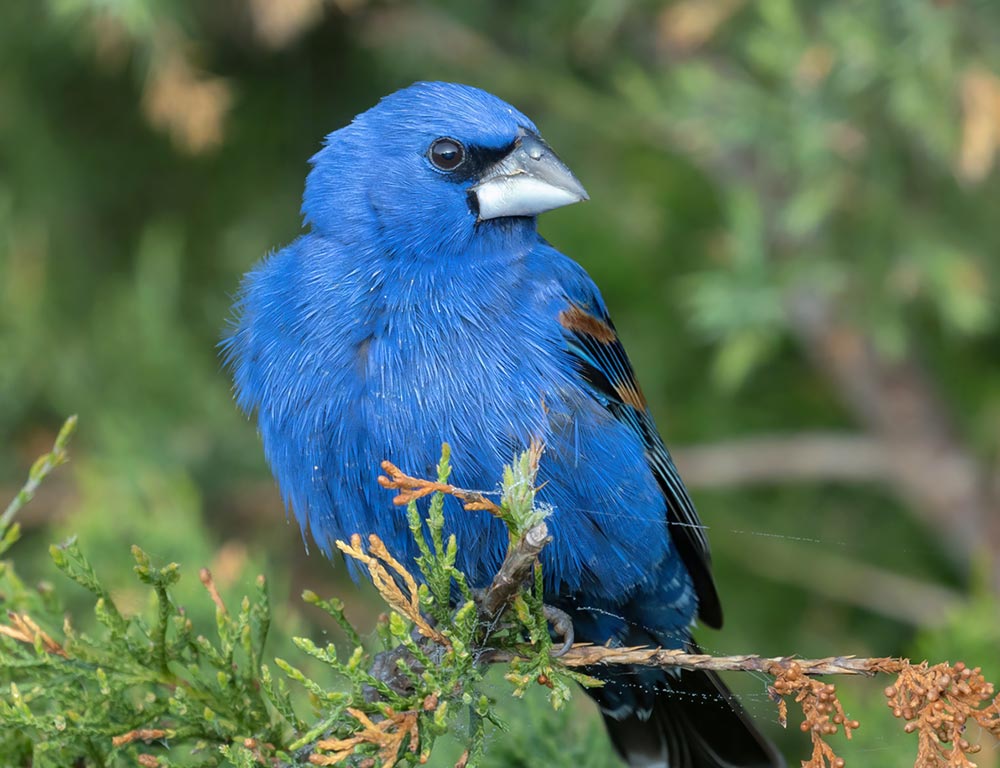
The Blue Grosbeak is a medium-sized North American passerine bird from the Cardinalidae family. It has striking plumage, with males showing off an impressive blue coloration and two brown wing bars.
Females are mainly brown with scattered blue feathers on the upperparts, but they also have two brown wing bars like males do.
During summer months these birds can be found in northern Mexico and the southern United States where they breed, while during wintertime they migrate to Central America for resting purposes.
This beautiful species of bird is easy to spot due to its vibrant colors making it a popular sight amongst wildlife observers.
Scientific classification:
| Kingdom | Animalia |
| Phylum | Chordata |
| Class | Aves |
| Order | Passeriformes |
| Family | Cardinalidae |
| Genus | Passerina |
| Species | P. caerulea |
34. Cooper’s Hawk
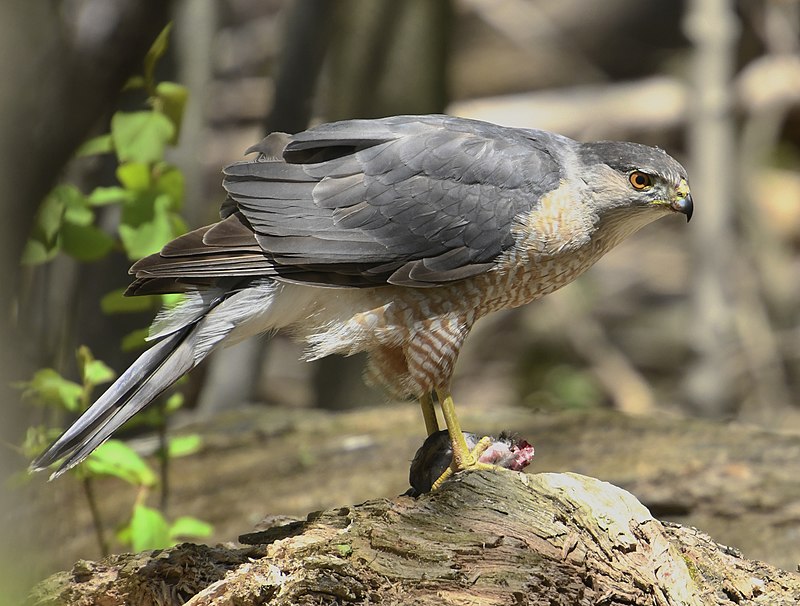
Cooper’s Hawk is a medium-sized bird of prey native to North America. It belongs to the Accipiter genus, which is known for its agility and small size compared to other hawks.
They usually inhabit wooded areas, making them well-adapted hunters in dense environments.
Cooper’s Hawks have rounded wings with short tails that help them maneuver quickly through trees when chasing after prey such as small rodents or birds.
These raptors also possess powerful feet equipped with sharp talons used for catching food items on the ground and even out of midair.
The adult plumage has barred upperparts, ranging from greyish brown on lighter individuals up to dark chestnut colors found in darker specimens; they also display rusty underparts marked by thin white streaking down either side of their chests and bellies.
Scientific classification:
| Kingdom | Animalia |
| Phylum | Chordata |
| Class | Aves |
| Order | Accipitriformes |
| Family | Accipitridae |
| Genus | Accipiter |
| Species | A. cooperii |
35. Scarlet Tanager

The Scarlet Tanager is a beautiful medium-sized bird found in parts of North and South America. It belongs to the Cardinal family and has striking red plumage with black wings and tail feathers.
Its song is similar to other cardinals yet also unique in its way – it’s recognizable by its high whistles that become lower towards the end.
The species feeds mainly on insects as well as berries from trees or shrubs during the breeding season, when they may form loose flocks over open woodlands foraging for food.
They are highly territorial birds during nesting season which happens between April and June each year; both males and females fiercely defend their nests against intruders such as cats or squirrels.
Scientific classification:
| Kingdom | Animalia |
| Phylum | Chordata |
| Class | Aves |
| Order | Passeriformes |
| Family | Cardinalidae |
| Genus | Piranga |
| Species | P. olivacea |
36. Blackburnian Warbler
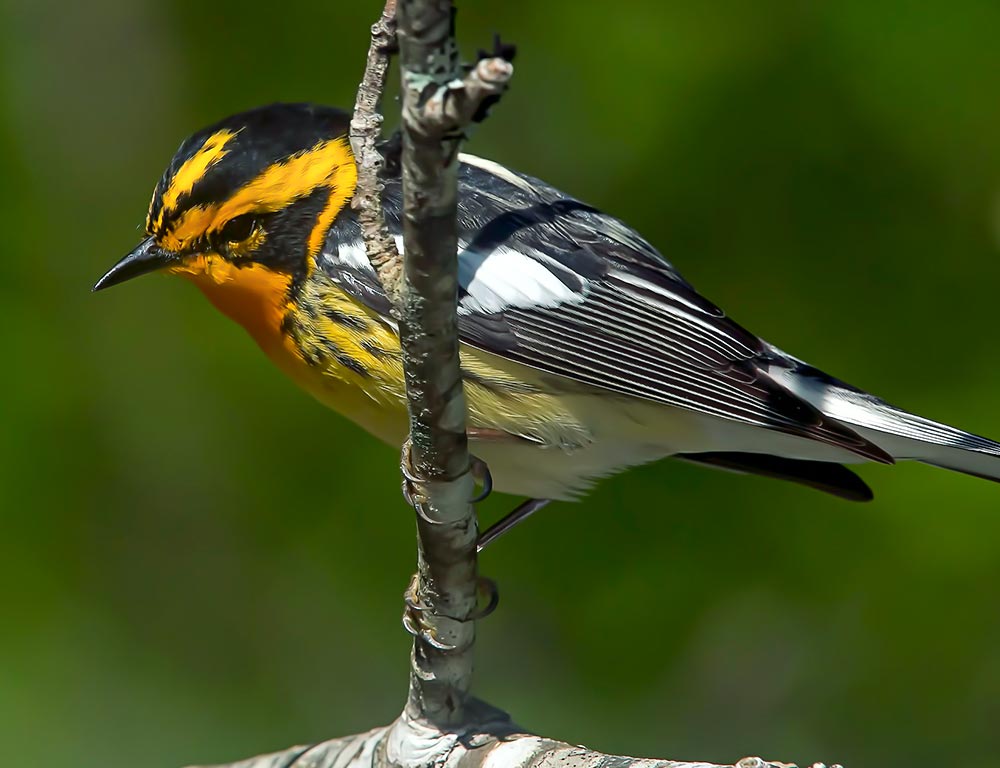
The Blackburnian warbler (Setophaga fusca) is a small New World songbird found primarily in eastern North America.
These birds breed from southern Canada, down to the Carolinas and as far west as the Canadian Prairies, Great Lakes region, and New England.
They are migratory birds, spending their winters in Central America or South America; they have also been recorded rarely in Western Europe.
The males of this species can be identified by their bright orange-red throat patches set against yellow head feathers.
Females may show some yellowish coloration but lack the distinct markings seen on male specimens.
This species feeds mainly on insects gleaned from tree branches during its breeding period; during migration, it will eat fruit or nectar for sustenance instead.
Scientific classification:
| Kingdom | Animalia |
| Phylum | Chordata |
| Class | Aves |
| Order | Passeriformes |
| Family | Parulidae |
| Genus | Setophaga |
| Species | S. fusca |
Also Featured In: Birds You’ll Find in Night, Adirondack Mountain Birds
37. American Wigeon
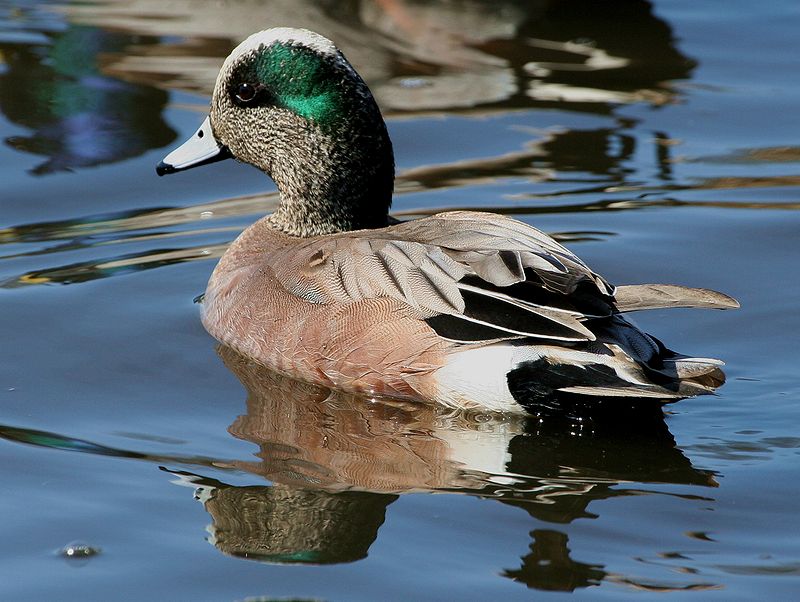
The American Wigeon, also known as the Baldpate, is a species of dabbling duck found throughout North America.
It closely resembles its Eurasian counterpart and was formally described in 1789 by German naturalist Johann Friedrich Gmelin.
This medium-sized bird has an overall grey body with white feathers on its face and belly that give it a distinctive bald appearance.
Its wings are brownish black with green speculum markings on them while the tail is dark brown or black at the base and gradually lightens near the tips to become chestnut-colored.
The male wigeons have purple patches on their heads during breeding season along with yellow eyes which helps differentiate them from females who have duller colors around their faces instead of bright ones like males possess.
Scientific classification:
| Kingdom | Animalia |
| Phylum | Chordata |
| Class | Aves |
| Order | Anseriformes |
| Family | Anatidae |
| Genus | Mareca |
| Species | M. americana |
38. Marsh Wren
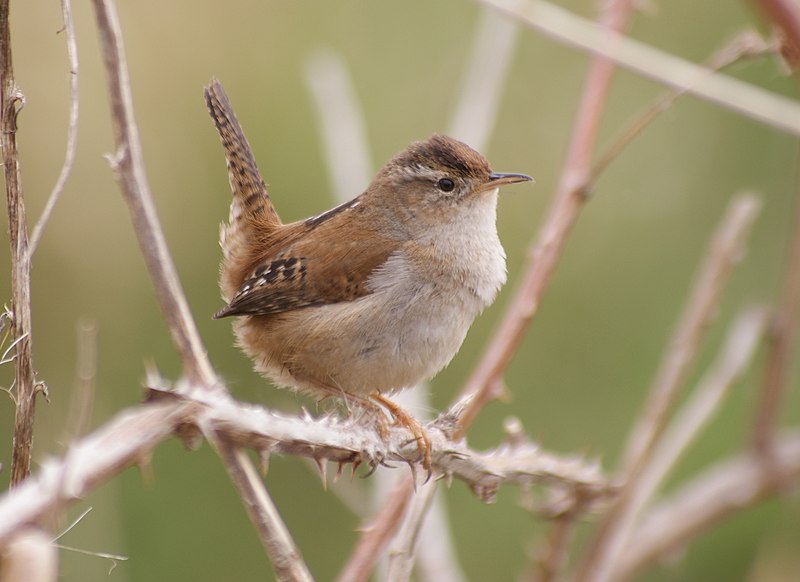
The Marsh Wren is a small bird native to North America, belonging to the Wren family. It has a long bill and can be distinguished from other species of marsh birds such as the sedge wren by its size.
The Marsh Wren was first described in 1810 by Alexander Wilson under the binomial name Certhia palustris and now belongs to the genus Cistothorus.
This songbird prefers wetland habitats like marshes, swamps, or wetlands with dense vegetation for sheltering and nesting activities.
They build nests on grasses near water bodies which are made out of twigs attached at one end forming an enclosed cup-like structure lined with feathers or fur making it look like a woven basket.
Scientific classification:
| Kingdom | Animalia |
| Phylum | Chordata |
| Class | Aves |
| Order | Passeriformes |
| Family | Troglodytidae |
| Genus | Cistothorus |
| Species | C. palustris |
39. American Avocet
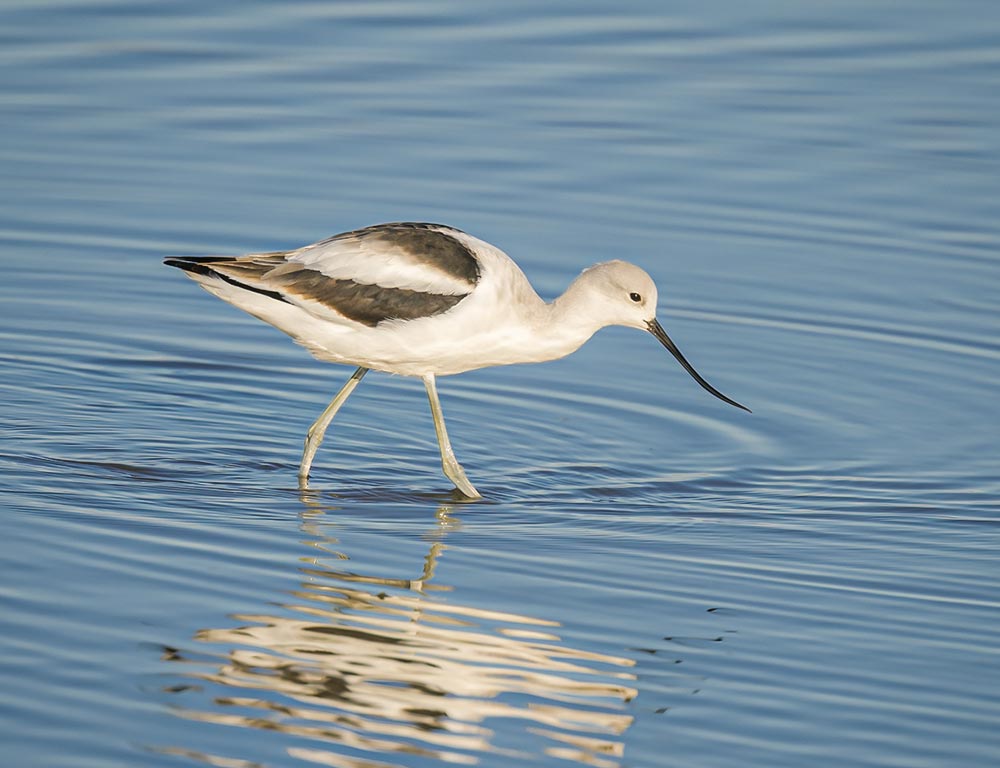
The American Avocet is a stunningly beautiful bird found in North America. With its striking black and white plumage, long blue legs, and upturned bill it is an unmistakable sight.
It spends much of its time foraging around shallow water or mud flats searching for crustaceans and insects to feed on by sweeping its beak from side to side through the water.
The German naturalist Johann Friedr formally described this species back in 1789 as Recurvirostra americana – aptly named due to their habit of recurving their bills when feeding.
These graceful wading birds are truly a marvel of nature that deserves our admiration.
Scientific classification:
| Kingdom | Animalia |
| Phylum | Chordata |
| Class | Aves |
| Order | Charadriiformes |
| Family | Recurvirostridae |
| Genus | Recurvirostra |
| Species | R. americana |
40. Spotted Sandpiper
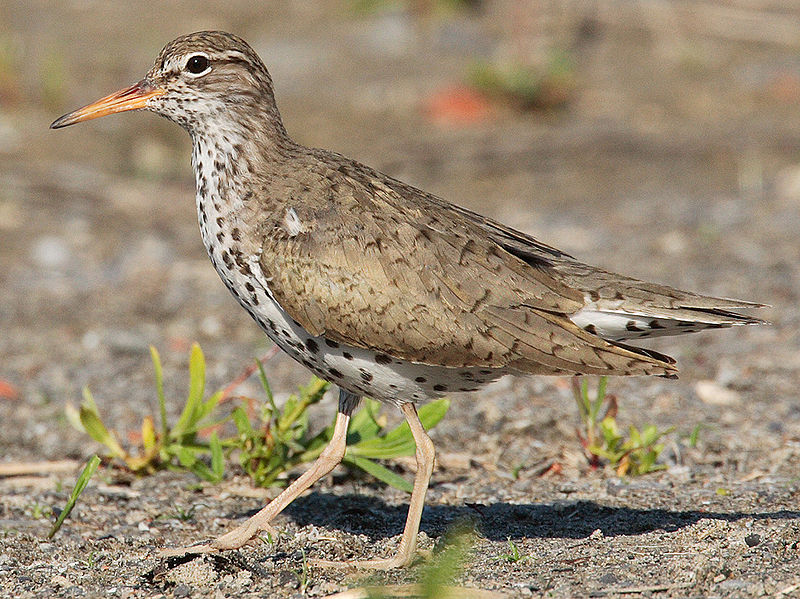
The Spotted sandpiper (Actitis macularius) is a small shorebird that can be found across North America and parts of South America.
It has an appealing spotted plumage, predominately brown with white spots on the wings, tail feathers, head, and neck.
The Common Sandpiper (A. hypoleucos) is its sister species which takes over geographically when the other moves away; they have been known to hybridize as well when strays settle down among breeders.
This bird was first described by Carl Linnaeus in 1766 in his twelfth edition of Systema Naturae as a migratory summer visitor to Europe but it now also occupies many habitats like beaches, riversides, and even grasslands during migration periods or for breeding season itself.
Its diet consists mainly of insects such as air-borne flies plus molluscs from shallow water areas – this makes them unique amongst waders.
Scientific classification:
| Kingdom | Animalia |
| Phylum | Chordata |
| Class | Aves |
| Order | Charadriiformes |
| Family | Scolopacidae |
| Genus | Actitis |
| Species | A. macularius |
41. Short-Billed Dowitcher
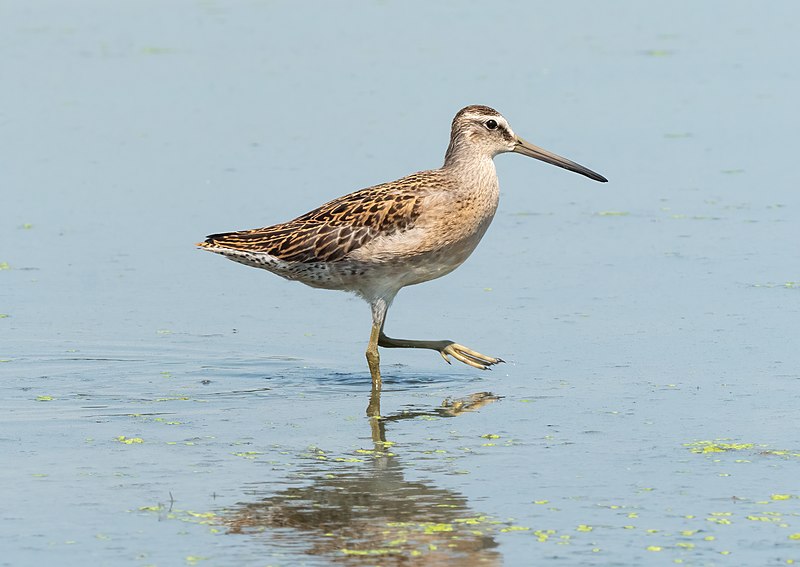
The Short-billed Dowitcher is a medium-sized bird belonging to the family Scolopacidae. It has a stocky body and long bill, making it easy to identify in its habitat of North America, Central America, the Caribbean, and northern South America.
Its strong migratory nature takes them away from their breeding grounds during winter months when snow covers these areas.
This species prefers varied habitats like mudflats and estuaries where they can feed on worms or other invertebrates found there with ease due to their long bills.
During summer they are often seen gathering around wetlands in large flocks which protect predators while also providing an opportunity for breeding activities among them.
Scientific classification:
| Kingdom | Animalia |
| Phylum | Chordata |
| Class | Aves |
| Order | Charadriiformes |
| Family | Scolopacidae |
| Genus | Limnodromus |
| Species | L. griseus |
Also Featured In: Birds in Pacific Northwest, Winged Marvels of St Martin’s: A Bird Enthusiast’s Delight
42. Green Heron
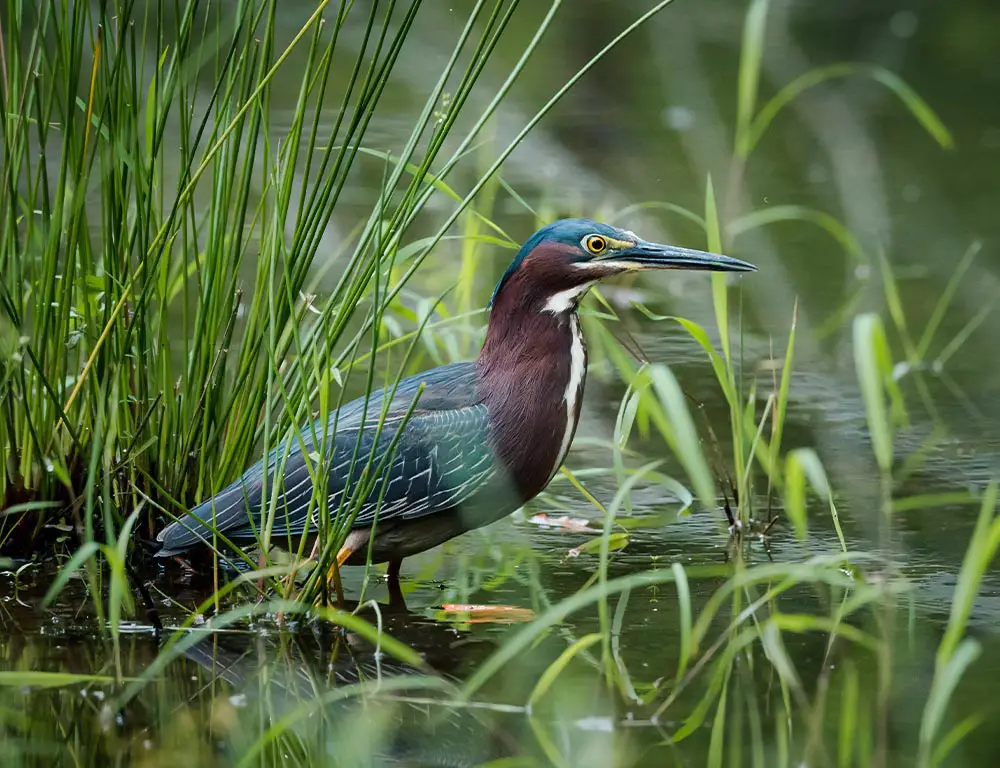
The Green Heron (Butorides virescens) is a small heron found throughout North and Central America.
Its scientific name comes from the Middle English ‘butor’ meaning bittern, combined with the Latin term for its distinctive greenish color – ‘virescens’.
For many years it was considered to be part of the same species as the Striated Heron (Butorides striata), commonly referred to as “green-backed herons”.
The nominate subspecies inhabits wetlands across much of this range, where they can be spotted stalking about in shallow water looking for fish or frogs on which to feed.
They are fascinating wading birds that have even been known to use tools such as sticks or baited lines when fishing.
Scientific classification:
| Kingdom | Animalia |
| Phylum | Chordata |
| Class | Aves |
| Order | Pelecaniformes |
| Family | Ardeidae |
| Genus | Butorides |
| Species | B. virescens |
43. Field Sparrow
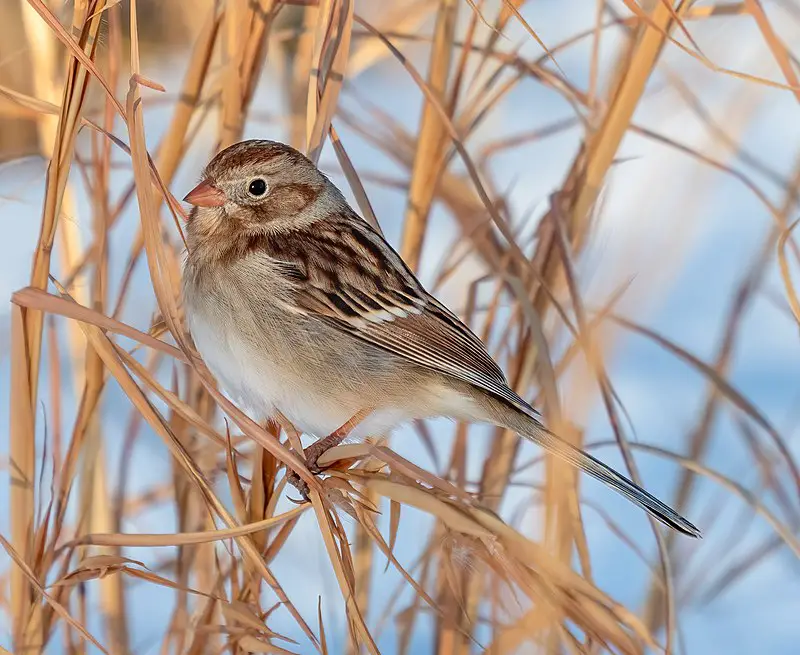
The Field Sparrow is a small bird that can be found across North America. It has a gray head with a rust-colored crown and white eye-ring, while its upper parts are brown streaked with black and buff feathers.
Its breast is buff colored, its belly white, and the tail forked. There are two color morphs of this species; one being darker in color than the other.
They measure about 140 mm long and weigh 12.5 grams on average; feeding primarily on seeds from grasses or weeds as well as insects during summer months.
The field sparrow’s song is often described as sweet whistles which it sings from an exposed perch like fence posts or tree tops.
Scientific classification:
| Kingdom | Animalia |
| Phylum | Chordata |
| Class | Aves |
| Order | Passeriformes |
| Family | Passerellidae |
| Genus | Spizella |
| Species | S. pusilla |
44. Blue-Winged Warbler
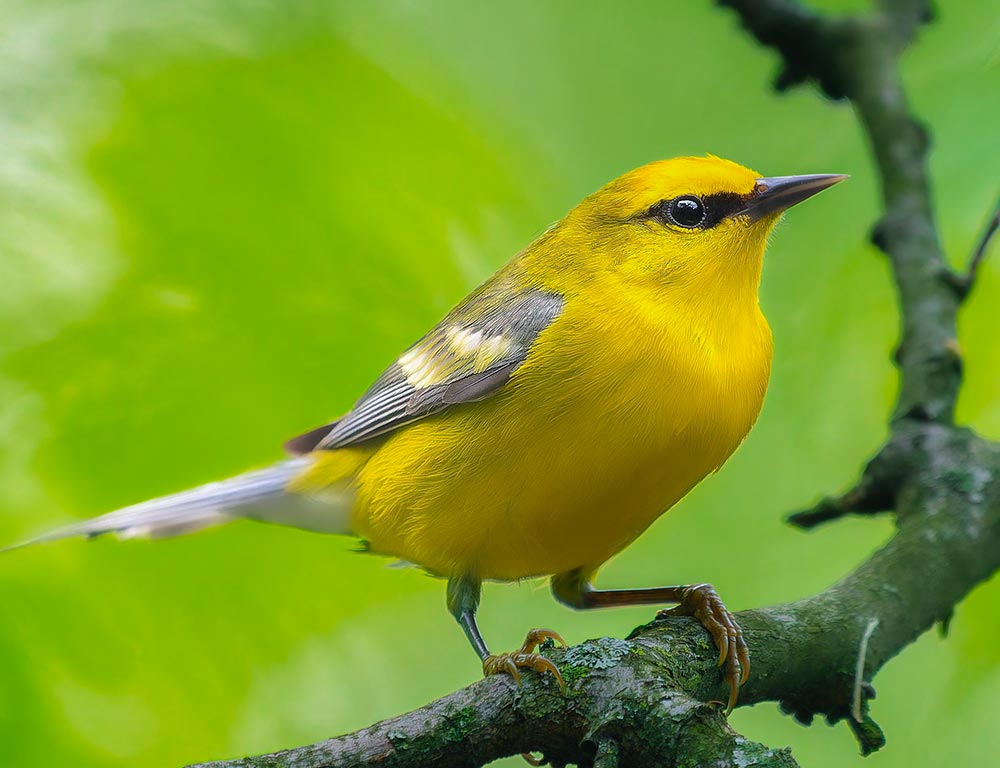
The Blue-winged Warbler is a common species of New World warbler, measuring 11.5 cm (4.5 in) long and weighing 8.5 g (0.30 oz).
It breeds mainly in eastern North America from southern Ontario to the US east coast, with its range gradually expanding northwards as it replaces its closely related cousin – the Golden-winged Warbler – in these parts of the world.
The name “Blue-winged” refers to its distinctive blue wings which contrast sharply against an olive green body plumage and white underparts scattered with yellow spots or streaks on either side of the breast region.
Males often have brighter colors than females do during breeding season, while nonbreeding birds tend to be duller overall regardless of sex difference.
Its diet consists mostly of insect prey items such as caterpillars, beetles & moths that are gleaned off foliage or caught midflight by this active forager.
Scientific classification:
| Kingdom | Animalia |
| Phylum | Chordata |
| Class | Aves |
| Order | Passeriformes |
| Family | Parulidae |
| Genus | Vermivora |
| Species | V. cyanoptera |
45. Snowy Egret
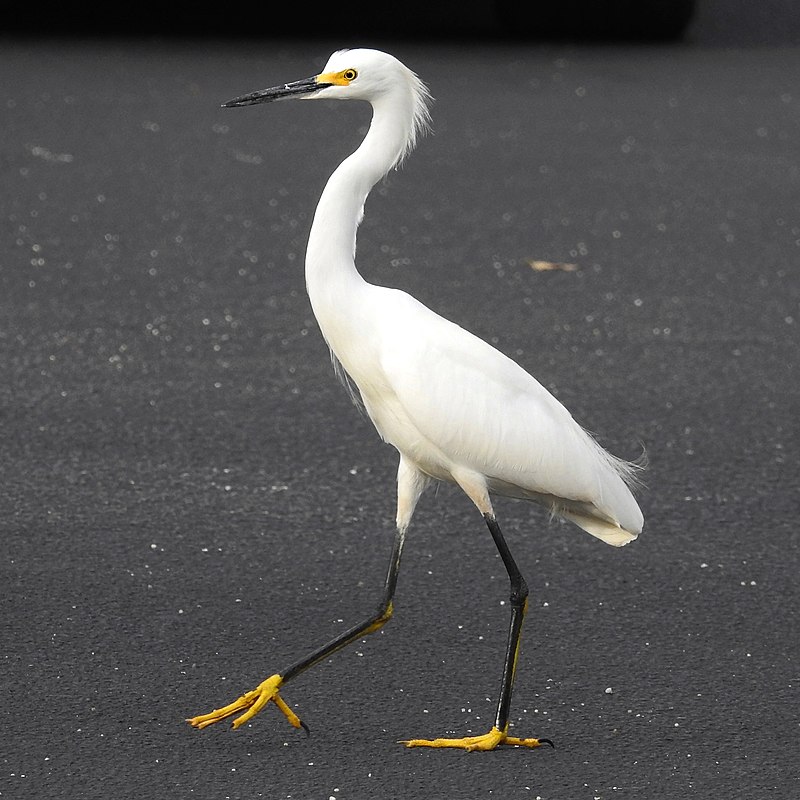
The Snowy Egret is a small white heron native to North America. Its scientific name, Egretta thula, comes from Provençal French for the little egret and an incorrect reference to the Black-necked Swan by Chilean naturalist Juan Ignacio Molina in 1782.
This beautiful bird has black legs yellow feet, and a long plume of feathers on its head that often appears as if it’s wearing a crown.
It feeds primarily on insects and aquatic life like fish or frogs making it well adapted for both wetland habitats such as marshes or swamps plus coastal areas close to shorelines.
With their graceful movements, they are truly delightful creatures to observe while out exploring nature.
Scientific classification:
| Kingdom | Animalia |
| Phylum | Chordata |
| Class | Aves |
| Order | Pelecaniformes |
| Family | Ardeidae |
| Genus | Egretta |
| Species | E. thula |
46. Cerulean Warbler
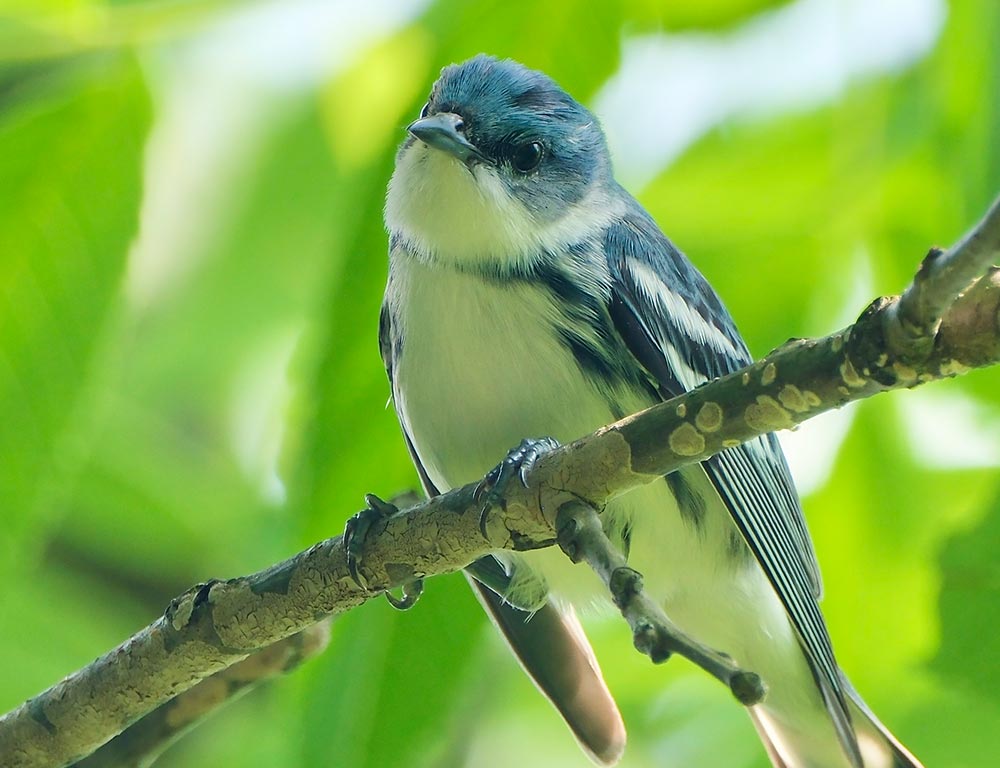
The Cerulean Warbler is a small songbird in the Parulidae family. It migrates long distances, breeding in eastern North American hardwood forests and spending its non-breeding season on the east slope of the Andes in South America.
This bird displays strong sexual dichromatism with adult males having vivid cerulean blue and white upperparts with black streaks running down their neck to the chest area.
Females have an olive green color above with yellowish tones beneath them, along with some dark streaks as well.
These birds feed mainly on insects but also consume fruits during migration or when rearing young ones.
They make nests near tree trunks and lay three to five eggs per clutch which hatch after about 10 days of incubation by both parents.
The Cerulean Warbler is classified as Near Threatened due to human disturbances such as habitat loss caused by deforestation amongst other factors like climate change that threaten this species’ survival.
Scientific classification:
| Kingdom | Animalia |
| Phylum | Chordata |
| Class | Aves |
| Order | Passeriformes |
| Family | Parulidae |
| Genus | Setophaga |
| Species | S. cerulea |
47. American White Ibis
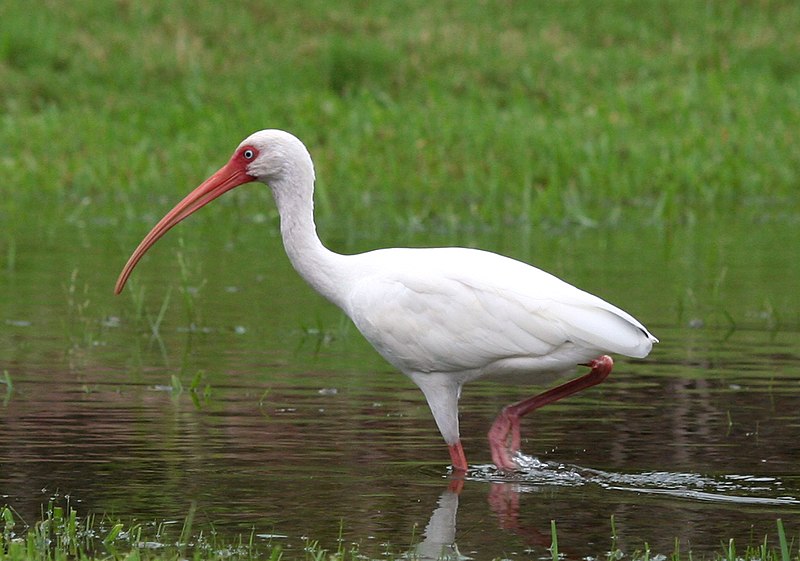
The American white ibis is a medium-sized bird with an overall white plumage and long legs. It has a bright red-orange downward curved bill, and black wing tips that are usually only visible in flight.
This species of ibis can be found from Virginia south through most of the coastal New World tropics.
They have been known to inhabit marshes, swamps, ponds, lakeshores as well as mangrove forests near water sources where they feed on crustaceans such as crabs and shrimp among other aquatic animals like insects or snails.
The American white ibis plays an important role in its ecosystem by helping to control insect populations which helps maintain balance within these environments.
Scientific classification:
| Kingdom | Animalia |
| Phylum | Chordata |
| Class | Aves |
| Order | Pelecaniformes |
| Family | Threskiornithidae |
| Genus | Eudocimus |
| Species | E. albus |
48. Blue-Headed Vireo
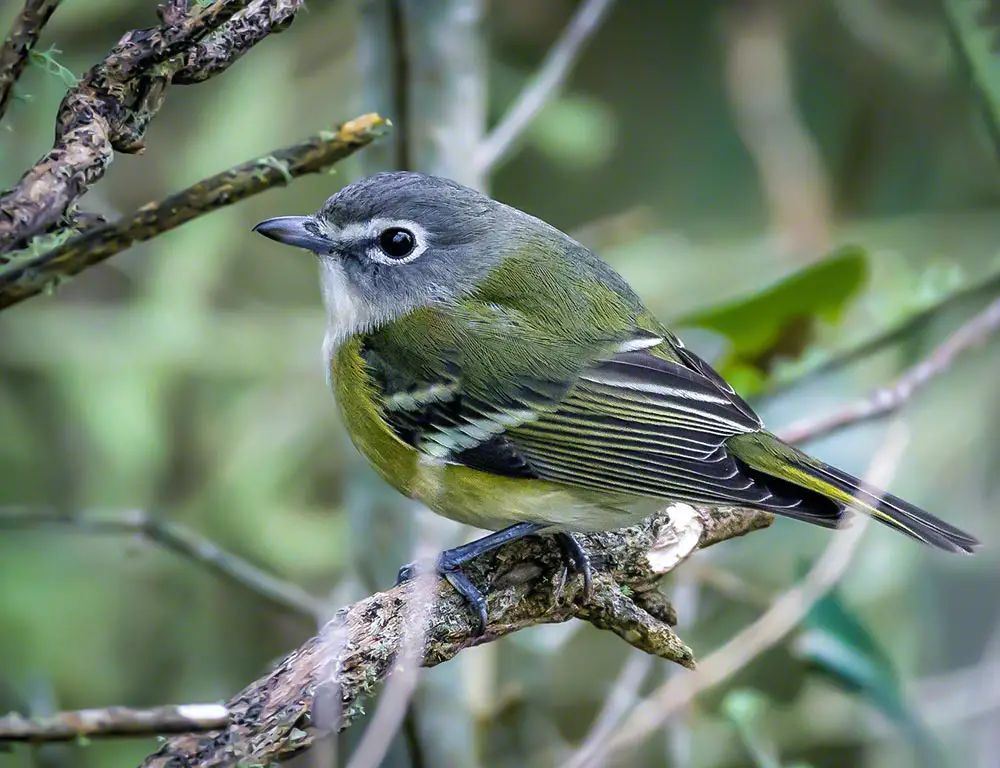
The Blue-headed Vireo is a small, migratory songbird found in North and Central America.
In summer it inhabits large temperate forests with a mix of evergreen trees and deciduous shrubs before migrating south to warmer climates during the winter months.
It has two recognized subspecies: one that breeds from Canada through Mexico, then down into parts of Central America; while the other resides exclusively in Cuba.
Its feathers are predominantly olive green with white underparts and wings marked by yellowish edges on its primary coverts.
The most distinguishing feature, however, is its bright blue head which explains why it’s named after this characteristic trait.
Scientific classification:
| Kingdom | Animalia |
| Phylum | Chordata |
| Class | Aves |
| Order | Passeriformes |
| Family | Vireonidae |
| Genus | Vireo |
| Species | V. solitarius |
Also Featured In: New Hampshire Birds You Should Know, Acadia National Park Birds
49. Least Tern
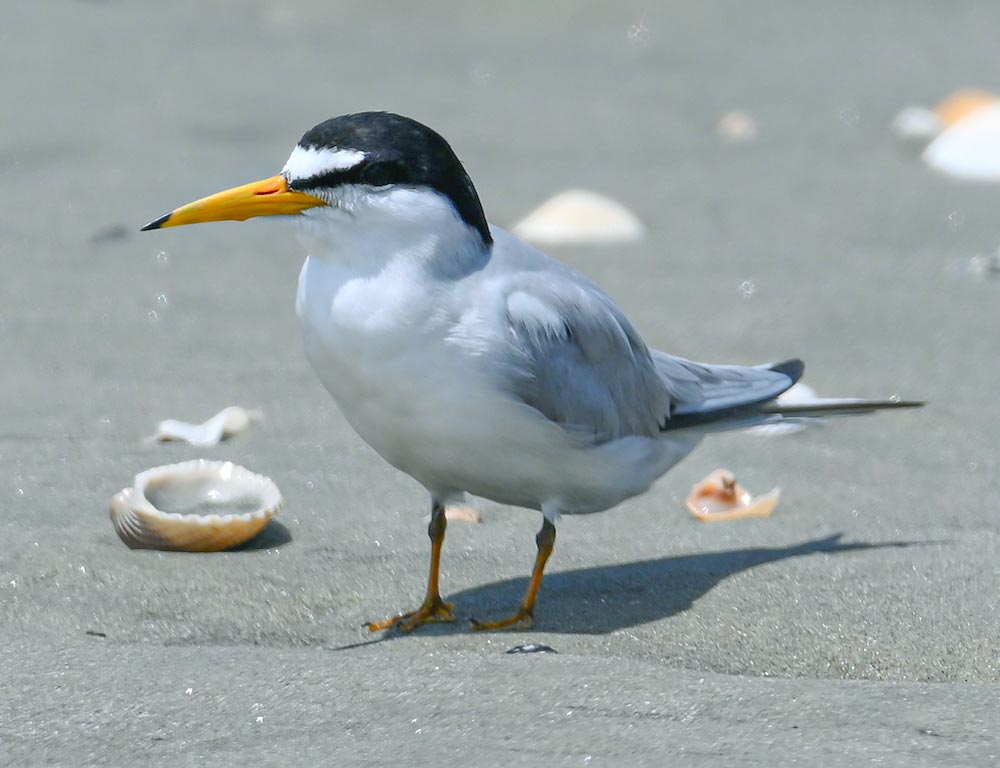
The Least Tern is a species of tern native to North America and northern South America. It has many close relatives, such as the yellow-billed tern and Peruvian tern from South America, or the little tern from the Old World.
The bird measures 8.7 – 9.4 inches in length with a wingspan of 16–18 inches across, making it an intermediate size between most other species of birds within its family groupings.
Its feathers are usually gray on top with white underneath and typically have darker accents near their heads along with bright red bills for feeding during summer months when they mate upon beaches found throughout these regions mentioned above.
They feed mainly on small fish that live at shallow depths near shorelines where they also nest nearby due to migratory patterns which take place annually each year.
Hence why this particular bird does not travel far distances away from areas known as home for them over long periods like some other types do.
Scientific classification:
| Kingdom | Animalia |
| Phylum | Chordata |
| Class | Aves |
| Order | Charadriiformes |
| Family | Laridae |
| Genus | Sternula |
| Species | S. antillarum |
50. Black Skimmer
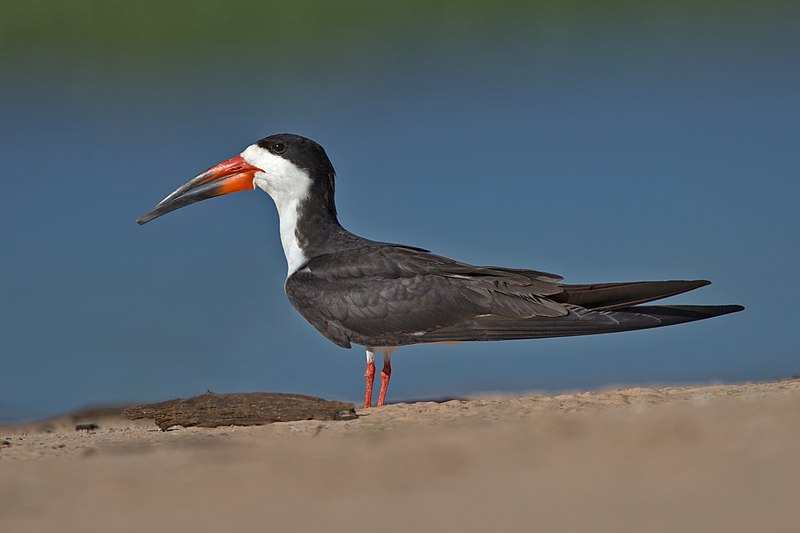
The Black Skimmer is a seabird that belongs to the skimmer genus Rynchops and Laridae family.
It breeds in North and South America, while Northern populations migrate south for winter towards warmer climates such as the Caribbean or Pacific coasts.
The Southern American races have adapted to annual floods by making shorter migrations during this time.
These birds are easily identified by their unique long red bill that has an upper mandible longer than its lower mandible.
They feed mainly on small fish caught at night when they skim across shallow water using their beak like a knife cutting through waves of water.
Their dark grey back contrasts against white belly feathers creating beautiful patterns in flight, aiding them in catching prey easier due to their camouflage effect above and below the water’s surface.
Scientific classification:
| Kingdom | Animalia |
| Phylum | Chordata |
| Class | Aves |
| Order | Charadriiformes |
| Family | Laridae |
| Genus | Rynchops |
| Species | R. niger |
Conclusion
This Birdwatcher’s Guide has opened the door to the breathtaking world of Mississippi’s avian treasures. We’ve embarked on a journey through the state’s diverse landscapes, from the lush forests to the meandering rivers, to discover and appreciate 50 spectacular bird species.
Whether you’re a seasoned birder or a novice enthusiast, the beauty of Mississippi’s winged inhabitants is bound to captivate your heart.
Remember that with this privilege comes responsibility. By respecting their habitats, preserving their ecosystems, and supporting local conservation efforts, we can ensure the continued presence of these remarkable birds.
Let this guide be your inspiration to cherish, protect, and celebrate Mississippi’s feathered wonders for generations to come.